doing 2.0.18 → 2.0.22
Sign up to get free protection for your applications and to get access to all the features.
- checksums.yaml +4 -4
- data/CHANGELOG.md +22 -0
- data/Gemfile.lock +15 -5
- data/README.md +1 -1
- data/bin/doing +2 -18
- data/doing.gemspec +5 -4
- data/doing.rdoc +2 -2
- data/generate_completions.sh +3 -3
- data/lib/doing/cli_status.rb +6 -2
- data/lib/doing/completion/bash_completion.rb +185 -0
- data/lib/doing/completion/fish_completion.rb +175 -0
- data/lib/doing/completion/string.rb +17 -0
- data/lib/doing/completion/zsh_completion.rb +140 -0
- data/lib/doing/completion.rb +39 -0
- data/lib/doing/version.rb +1 -1
- data/lib/doing/wwid.rb +18 -6
- data/lib/doing.rb +1 -1
- data/lib/helpers/fzf/.goreleaser.yml +119 -0
- data/lib/helpers/fzf/.rubocop.yml +28 -0
- data/lib/helpers/fzf/ADVANCED.md +565 -0
- data/lib/helpers/fzf/BUILD.md +49 -0
- data/lib/helpers/fzf/CHANGELOG.md +1193 -0
- data/lib/helpers/fzf/Dockerfile +11 -0
- data/lib/helpers/fzf/LICENSE +21 -0
- data/lib/helpers/fzf/Makefile +166 -0
- data/lib/helpers/fzf/README-VIM.md +486 -0
- data/lib/helpers/fzf/README.md +712 -0
- data/lib/helpers/fzf/bin/fzf-tmux +233 -0
- data/lib/helpers/fzf/doc/fzf.txt +512 -0
- data/lib/helpers/fzf/go.mod +17 -0
- data/lib/helpers/fzf/go.sum +31 -0
- data/lib/helpers/fzf/install +382 -0
- data/lib/helpers/fzf/install.ps1 +65 -0
- data/lib/helpers/fzf/main.go +14 -0
- data/lib/helpers/fzf/man/man1/fzf-tmux.1 +68 -0
- data/lib/helpers/fzf/man/man1/fzf.1 +1001 -0
- data/lib/helpers/fzf/plugin/fzf.vim +1048 -0
- data/lib/helpers/fzf/shell/completion.bash +381 -0
- data/lib/helpers/fzf/shell/completion.zsh +329 -0
- data/lib/helpers/fzf/shell/key-bindings.bash +96 -0
- data/lib/helpers/fzf/shell/key-bindings.fish +172 -0
- data/lib/helpers/fzf/shell/key-bindings.zsh +114 -0
- data/lib/helpers/fzf/src/LICENSE +21 -0
- data/lib/helpers/fzf/src/algo/algo.go +884 -0
- data/lib/helpers/fzf/src/algo/algo_test.go +197 -0
- data/lib/helpers/fzf/src/algo/normalize.go +492 -0
- data/lib/helpers/fzf/src/ansi.go +409 -0
- data/lib/helpers/fzf/src/ansi_test.go +427 -0
- data/lib/helpers/fzf/src/cache.go +81 -0
- data/lib/helpers/fzf/src/cache_test.go +39 -0
- data/lib/helpers/fzf/src/chunklist.go +89 -0
- data/lib/helpers/fzf/src/chunklist_test.go +80 -0
- data/lib/helpers/fzf/src/constants.go +85 -0
- data/lib/helpers/fzf/src/core.go +351 -0
- data/lib/helpers/fzf/src/history.go +96 -0
- data/lib/helpers/fzf/src/history_test.go +68 -0
- data/lib/helpers/fzf/src/item.go +44 -0
- data/lib/helpers/fzf/src/item_test.go +23 -0
- data/lib/helpers/fzf/src/matcher.go +235 -0
- data/lib/helpers/fzf/src/merger.go +120 -0
- data/lib/helpers/fzf/src/merger_test.go +88 -0
- data/lib/helpers/fzf/src/options.go +1691 -0
- data/lib/helpers/fzf/src/options_test.go +457 -0
- data/lib/helpers/fzf/src/pattern.go +425 -0
- data/lib/helpers/fzf/src/pattern_test.go +209 -0
- data/lib/helpers/fzf/src/protector/protector.go +8 -0
- data/lib/helpers/fzf/src/protector/protector_openbsd.go +10 -0
- data/lib/helpers/fzf/src/reader.go +201 -0
- data/lib/helpers/fzf/src/reader_test.go +63 -0
- data/lib/helpers/fzf/src/result.go +243 -0
- data/lib/helpers/fzf/src/result_others.go +16 -0
- data/lib/helpers/fzf/src/result_test.go +159 -0
- data/lib/helpers/fzf/src/result_x86.go +16 -0
- data/lib/helpers/fzf/src/terminal.go +2832 -0
- data/lib/helpers/fzf/src/terminal_test.go +638 -0
- data/lib/helpers/fzf/src/terminal_unix.go +26 -0
- data/lib/helpers/fzf/src/terminal_windows.go +45 -0
- data/lib/helpers/fzf/src/tokenizer.go +253 -0
- data/lib/helpers/fzf/src/tokenizer_test.go +112 -0
- data/lib/helpers/fzf/src/tui/dummy.go +46 -0
- data/lib/helpers/fzf/src/tui/light.go +987 -0
- data/lib/helpers/fzf/src/tui/light_unix.go +110 -0
- data/lib/helpers/fzf/src/tui/light_windows.go +145 -0
- data/lib/helpers/fzf/src/tui/tcell.go +721 -0
- data/lib/helpers/fzf/src/tui/tcell_test.go +392 -0
- data/lib/helpers/fzf/src/tui/ttyname_unix.go +47 -0
- data/lib/helpers/fzf/src/tui/ttyname_windows.go +14 -0
- data/lib/helpers/fzf/src/tui/tui.go +625 -0
- data/lib/helpers/fzf/src/tui/tui_test.go +20 -0
- data/lib/helpers/fzf/src/util/atomicbool.go +34 -0
- data/lib/helpers/fzf/src/util/atomicbool_test.go +17 -0
- data/lib/helpers/fzf/src/util/chars.go +198 -0
- data/lib/helpers/fzf/src/util/chars_test.go +46 -0
- data/lib/helpers/fzf/src/util/eventbox.go +96 -0
- data/lib/helpers/fzf/src/util/eventbox_test.go +61 -0
- data/lib/helpers/fzf/src/util/slab.go +12 -0
- data/lib/helpers/fzf/src/util/util.go +138 -0
- data/lib/helpers/fzf/src/util/util_test.go +40 -0
- data/lib/helpers/fzf/src/util/util_unix.go +47 -0
- data/lib/helpers/fzf/src/util/util_windows.go +83 -0
- data/lib/helpers/fzf/test/fzf.vader +175 -0
- data/lib/helpers/fzf/test/test_go.rb +2626 -0
- data/lib/helpers/fzf/uninstall +117 -0
- data/scripts/generate_bash_completions.rb +6 -12
- data/scripts/generate_fish_completions.rb +7 -16
- data/scripts/generate_zsh_completions.rb +6 -15
- metadata +144 -9
|
@@ -0,0 +1,565 @@
|
|
|
1
|
+
Advanced fzf examples
|
|
2
|
+
======================
|
|
3
|
+
|
|
4
|
+
*(Last update: 2021/05/22)*
|
|
5
|
+
|
|
6
|
+
<!-- vim-markdown-toc GFM -->
|
|
7
|
+
|
|
8
|
+
* [Introduction](#introduction)
|
|
9
|
+
* [Screen Layout](#screen-layout)
|
|
10
|
+
* [`--height`](#--height)
|
|
11
|
+
* [`fzf-tmux`](#fzf-tmux)
|
|
12
|
+
* [Popup window support](#popup-window-support)
|
|
13
|
+
* [Dynamic reloading of the list](#dynamic-reloading-of-the-list)
|
|
14
|
+
* [Updating the list of processes by pressing CTRL-R](#updating-the-list-of-processes-by-pressing-ctrl-r)
|
|
15
|
+
* [Toggling between data sources](#toggling-between-data-sources)
|
|
16
|
+
* [Ripgrep integration](#ripgrep-integration)
|
|
17
|
+
* [Using fzf as the secondary filter](#using-fzf-as-the-secondary-filter)
|
|
18
|
+
* [Using fzf as interative Ripgrep launcher](#using-fzf-as-interative-ripgrep-launcher)
|
|
19
|
+
* [Switching to fzf-only search mode](#switching-to-fzf-only-search-mode)
|
|
20
|
+
* [Log tailing](#log-tailing)
|
|
21
|
+
* [Key bindings for git objects](#key-bindings-for-git-objects)
|
|
22
|
+
* [Files listed in `git status`](#files-listed-in-git-status)
|
|
23
|
+
* [Branches](#branches)
|
|
24
|
+
* [Commit hashes](#commit-hashes)
|
|
25
|
+
* [Color themes](#color-themes)
|
|
26
|
+
* [Generating fzf color theme from Vim color schemes](#generating-fzf-color-theme-from-vim-color-schemes)
|
|
27
|
+
|
|
28
|
+
<!-- vim-markdown-toc -->
|
|
29
|
+
|
|
30
|
+
Introduction
|
|
31
|
+
------------
|
|
32
|
+
|
|
33
|
+
fzf is an interactive [Unix filter][filter] program that is designed to be
|
|
34
|
+
used with other Unix tools. It reads a list of items from the standard input,
|
|
35
|
+
allows you to select a subset of the items, and prints the selected ones to
|
|
36
|
+
the standard output. You can think of it as an interactive version of *grep*,
|
|
37
|
+
and it's already useful even if you don't know any of its options.
|
|
38
|
+
|
|
39
|
+
```sh
|
|
40
|
+
# 1. ps: Feed the list of processes to fzf
|
|
41
|
+
# 2. fzf: Interactively select a process using fuzzy matching algorithm
|
|
42
|
+
# 3. awk: Take the PID from the selected line
|
|
43
|
+
# 3. kill: Kill the process with the PID
|
|
44
|
+
ps -ef | fzf | awk '{print $2}' | xargs kill -9
|
|
45
|
+
```
|
|
46
|
+
|
|
47
|
+
[filter]: https://en.wikipedia.org/wiki/Filter_(software)
|
|
48
|
+
|
|
49
|
+
While the above example succinctly summarizes the fundamental concept of fzf,
|
|
50
|
+
you can build much more sophisticated interactive workflows using fzf once you
|
|
51
|
+
learn its wide variety of features.
|
|
52
|
+
|
|
53
|
+
- To see the full list of options and features, see `man fzf`
|
|
54
|
+
- To see the latest additions, see [CHANGELOG.md](CHANGELOG.md)
|
|
55
|
+
|
|
56
|
+
This document will guide you through some examples that will familiarize you
|
|
57
|
+
with the advanced features of fzf.
|
|
58
|
+
|
|
59
|
+
Screen Layout
|
|
60
|
+
-------------
|
|
61
|
+
|
|
62
|
+
### `--height`
|
|
63
|
+
|
|
64
|
+
fzf by default opens in fullscreen mode, but it's not always desirable.
|
|
65
|
+
Oftentimes, you want to see the current context of the terminal while using
|
|
66
|
+
fzf. `--height` is an option for opening fzf below the cursor in
|
|
67
|
+
non-fullscreen mode so you can still see the previous commands and their
|
|
68
|
+
results above it.
|
|
69
|
+
|
|
70
|
+
```sh
|
|
71
|
+
fzf --height=40%
|
|
72
|
+
```
|
|
73
|
+
|
|
74
|
+
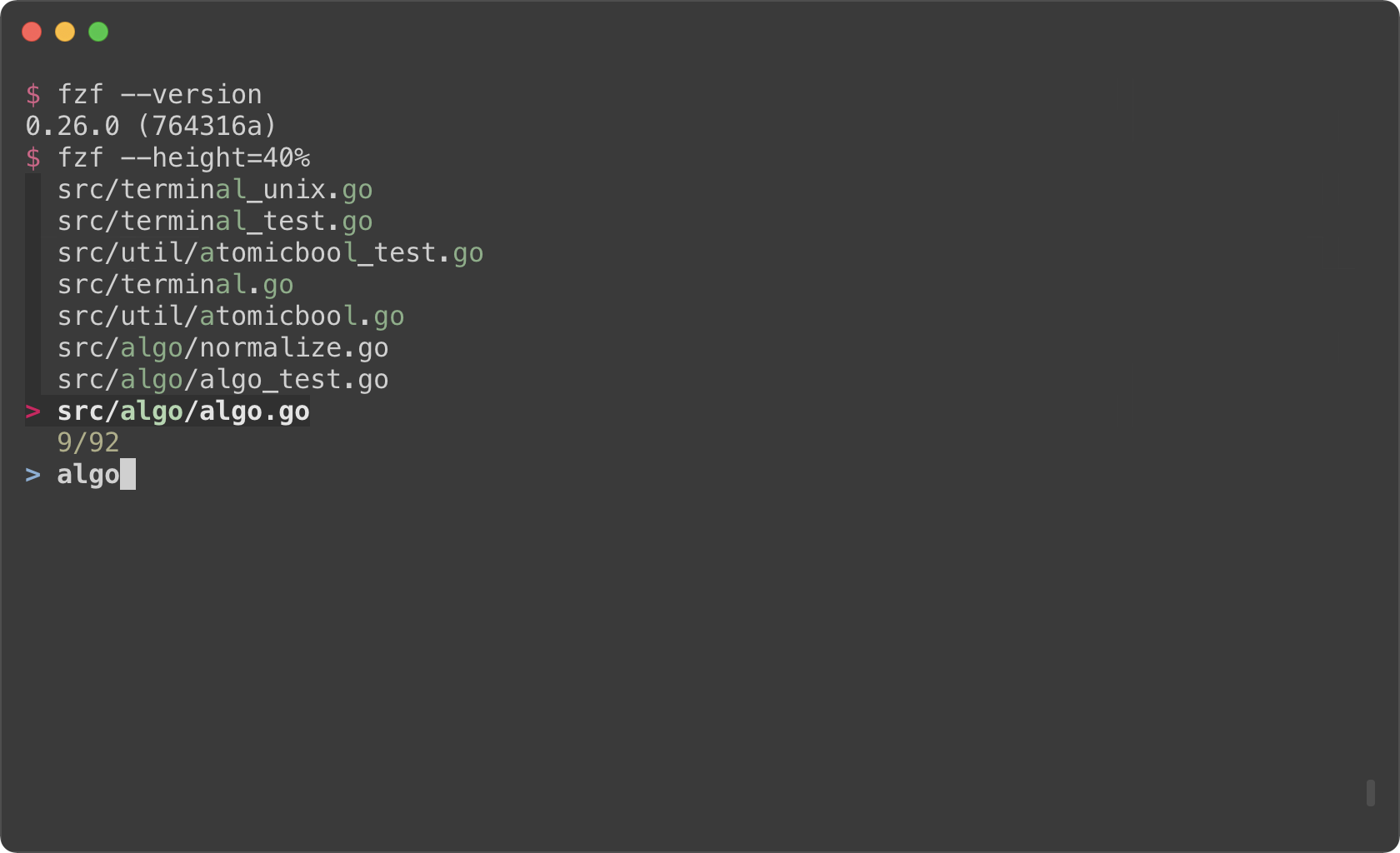
|
|
75
|
+
|
|
76
|
+
You might also want to experiment with other layout options such as
|
|
77
|
+
`--layout=reverse`, `--info=inline`, `--border`, `--margin`, etc.
|
|
78
|
+
|
|
79
|
+
```sh
|
|
80
|
+
fzf --height=40% --layout=reverse
|
|
81
|
+
fzf --height=40% --layout=reverse --info=inline
|
|
82
|
+
fzf --height=40% --layout=reverse --info=inline --border
|
|
83
|
+
fzf --height=40% --layout=reverse --info=inline --border --margin=1
|
|
84
|
+
fzf --height=40% --layout=reverse --info=inline --border --margin=1 --padding=1
|
|
85
|
+
```
|
|
86
|
+
|
|
87
|
+
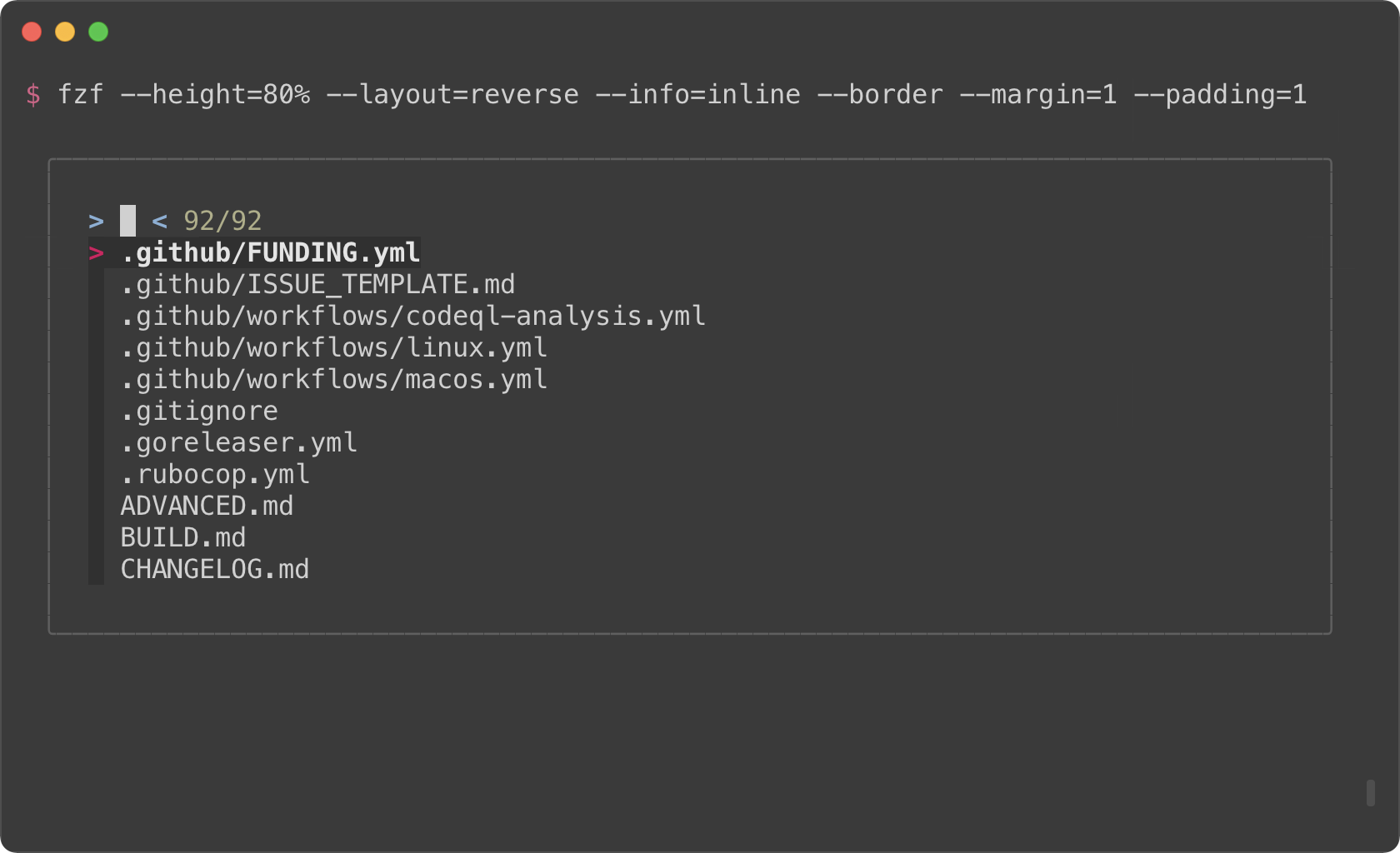
|
|
88
|
+
|
|
89
|
+
*(See `Layout` section of the man page to see the full list of options)*
|
|
90
|
+
|
|
91
|
+
But you definitely don't want to repeat `--height=40% --layout=reverse
|
|
92
|
+
--info=inline --border --margin=1 --padding=1` every time you use fzf. You
|
|
93
|
+
could write a wrapper script or shell alias, but there is an easier option.
|
|
94
|
+
Define `$FZF_DEFAULT_OPTS` like so:
|
|
95
|
+
|
|
96
|
+
```sh
|
|
97
|
+
export FZF_DEFAULT_OPTS="--height=40% --layout=reverse --info=inline --border --margin=1 --padding=1"
|
|
98
|
+
```
|
|
99
|
+
|
|
100
|
+
### `fzf-tmux`
|
|
101
|
+
|
|
102
|
+
Before fzf had `--height` option, we would open fzf in a tmux split pane not
|
|
103
|
+
to take up the whole screen. This is done using `fzf-tmux` script.
|
|
104
|
+
|
|
105
|
+
```sh
|
|
106
|
+
# Open fzf on a tmux split pane below the current pane.
|
|
107
|
+
# Takes the same set of options.
|
|
108
|
+
fzf-tmux --layout=reverse
|
|
109
|
+
```
|
|
110
|
+
|
|
111
|
+
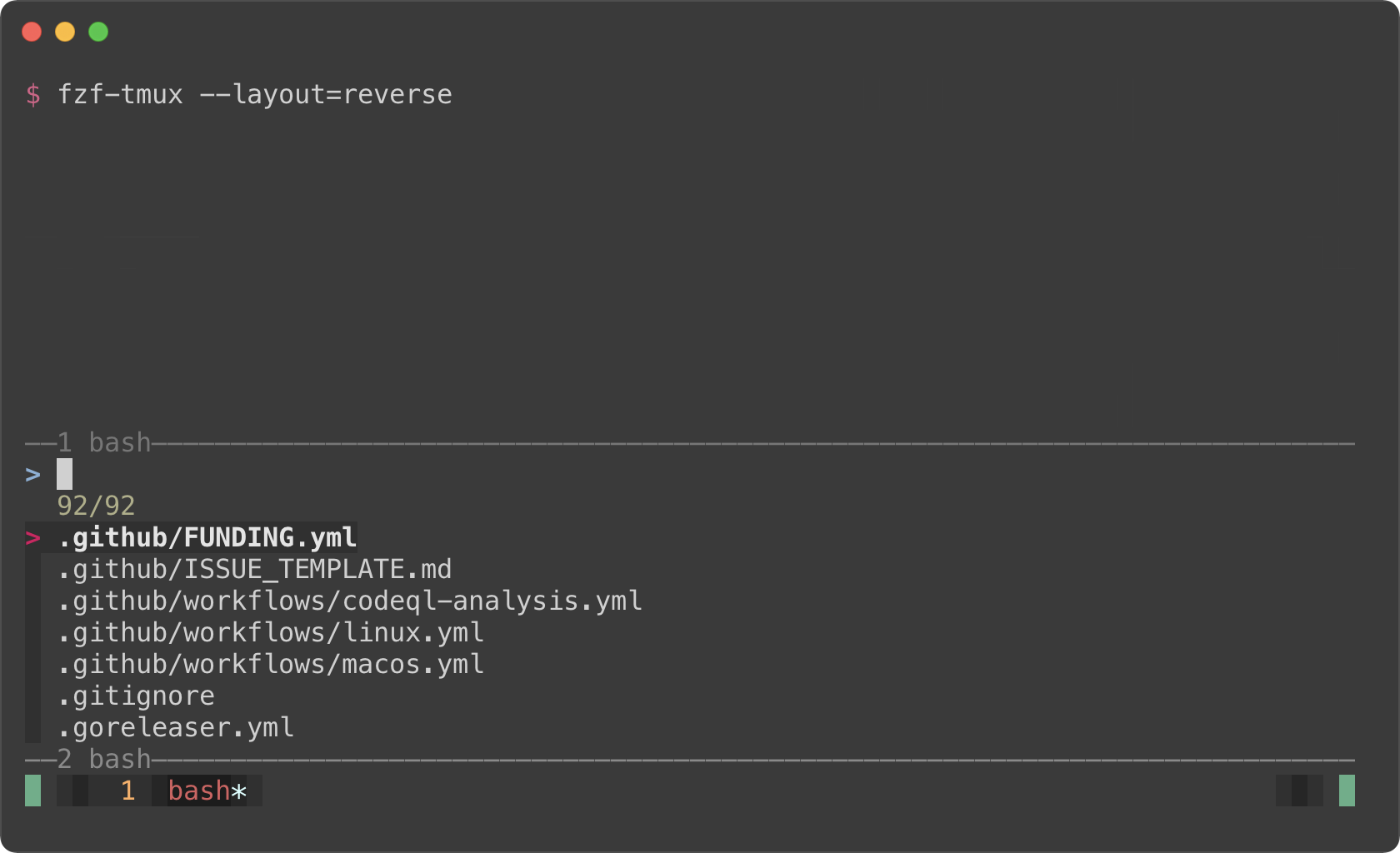
|
|
112
|
+
|
|
113
|
+
The limitation of `fzf-tmux` is that it only works when you're on tmux unlike
|
|
114
|
+
`--height` option. But the advantage of it is that it's more flexible.
|
|
115
|
+
(See `man fzf-tmux` for available options.)
|
|
116
|
+
|
|
117
|
+
```sh
|
|
118
|
+
# On the right (50%)
|
|
119
|
+
fzf-tmux -r
|
|
120
|
+
|
|
121
|
+
# On the left (30%)
|
|
122
|
+
fzf-tmux -l30%
|
|
123
|
+
|
|
124
|
+
# Above the cursor
|
|
125
|
+
fzf-tmux -u30%
|
|
126
|
+
```
|
|
127
|
+
|
|
128
|
+
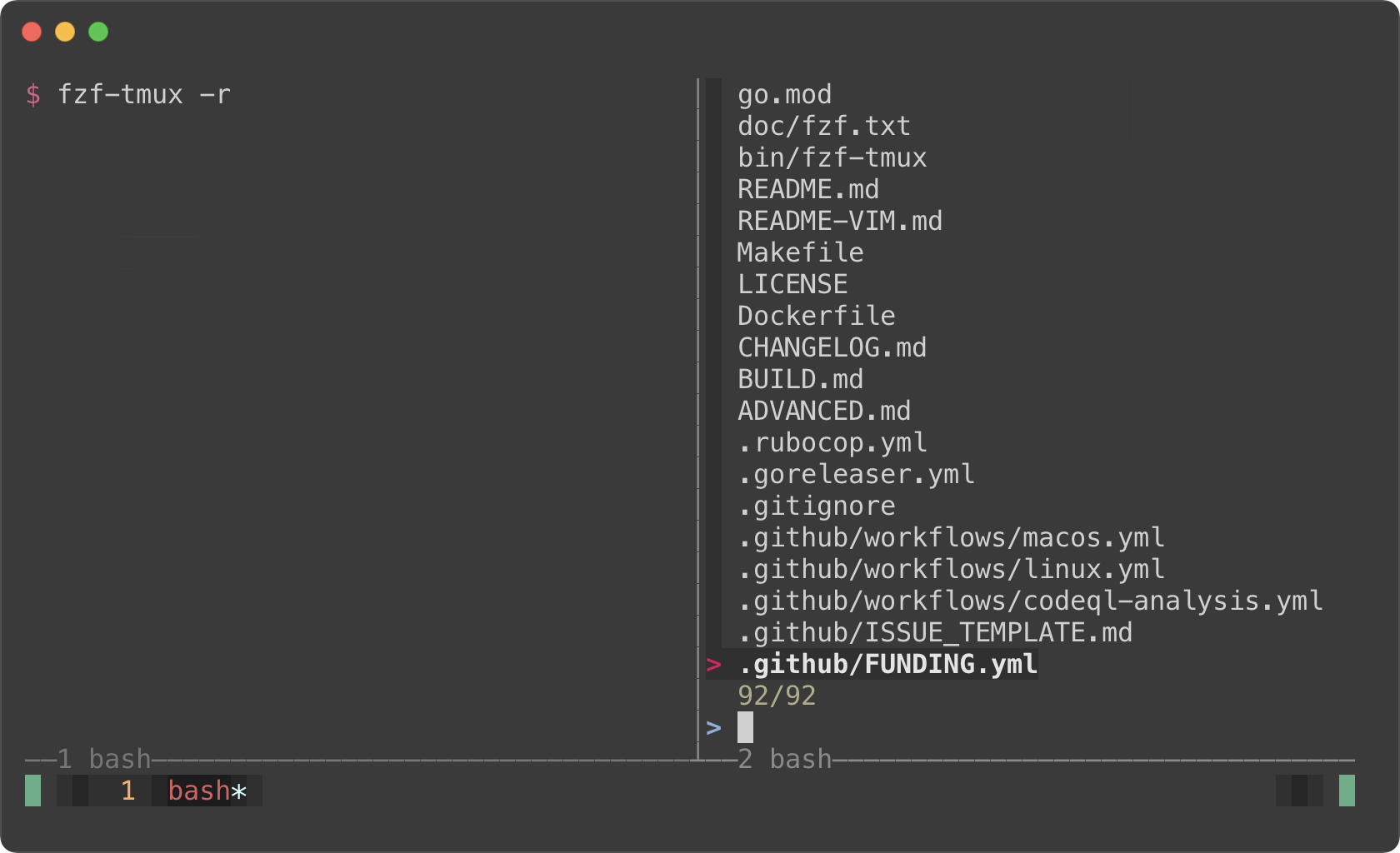
|
|
129
|
+
|
|
130
|
+
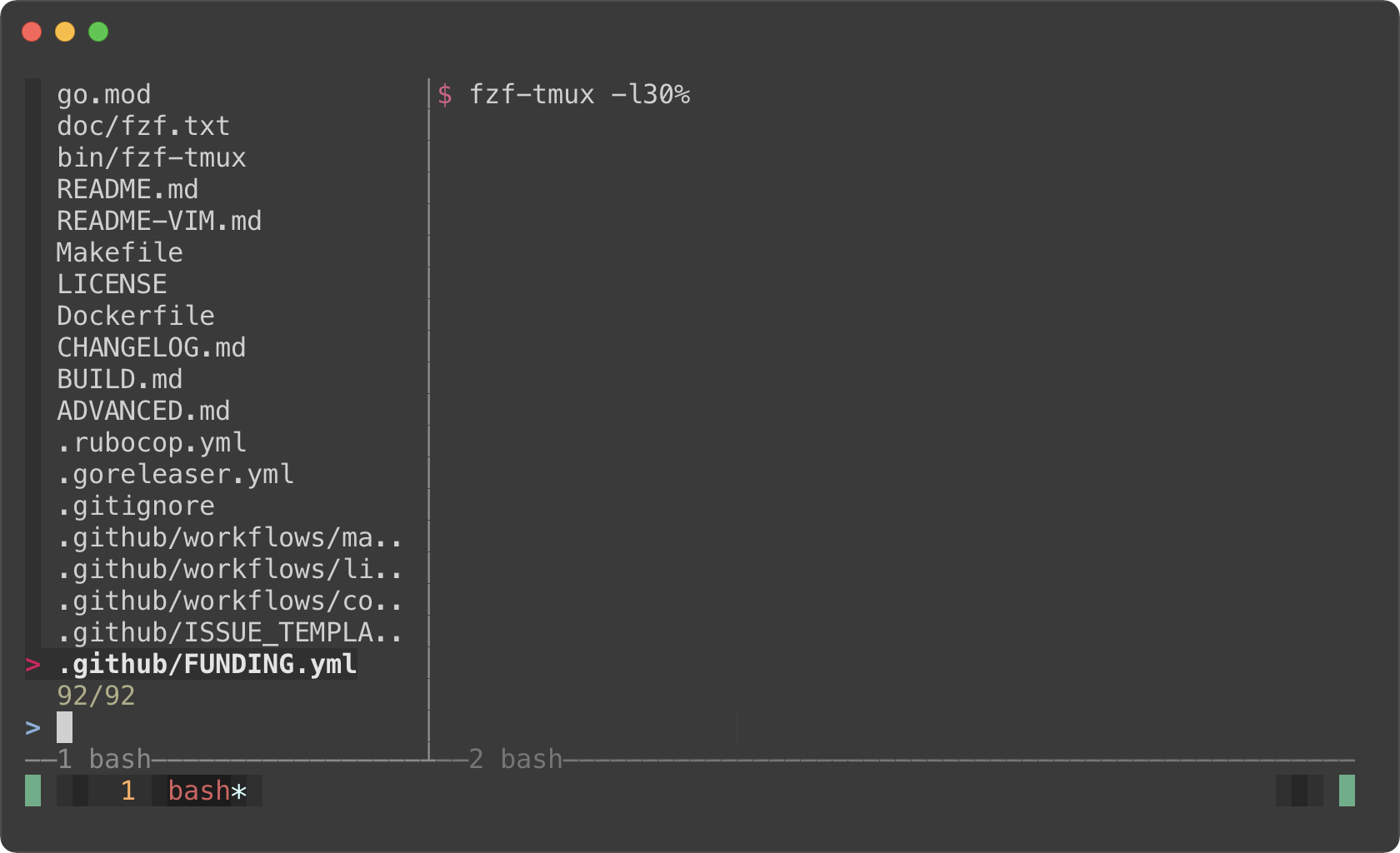
|
|
131
|
+
|
|
132
|
+
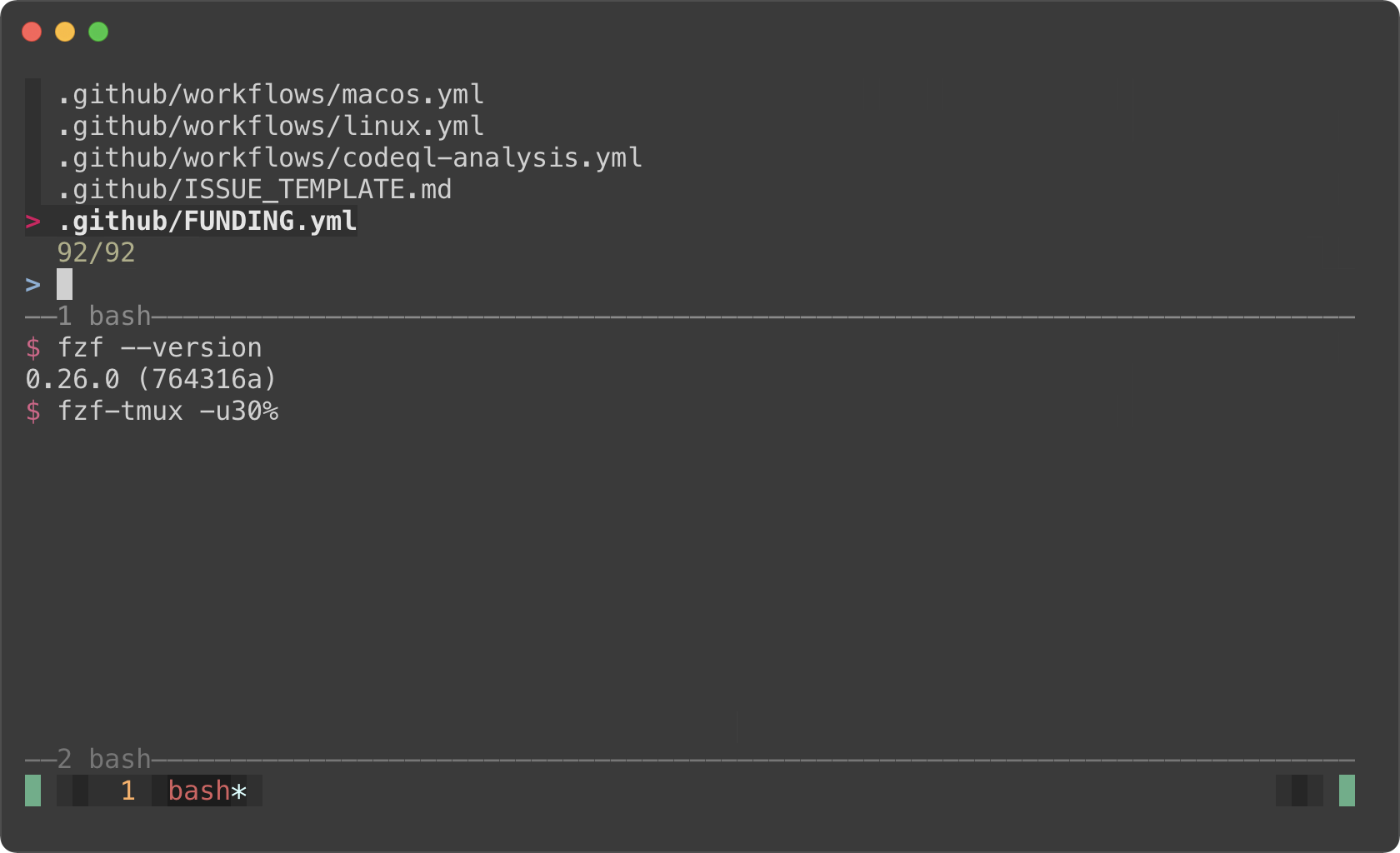
|
|
133
|
+
|
|
134
|
+
#### Popup window support
|
|
135
|
+
|
|
136
|
+
But here's the really cool part; tmux 3.2 added support for popup windows. So
|
|
137
|
+
you can open fzf in a popup window, which is quite useful if you frequently
|
|
138
|
+
use split panes.
|
|
139
|
+
|
|
140
|
+
```sh
|
|
141
|
+
# Open tmux in a tmux popup window (default size: 50% of the screen)
|
|
142
|
+
fzf-tmux -p
|
|
143
|
+
|
|
144
|
+
# 80% width, 60% height
|
|
145
|
+
fzf-tmux -p 80%,60%
|
|
146
|
+
```
|
|
147
|
+
|
|
148
|
+
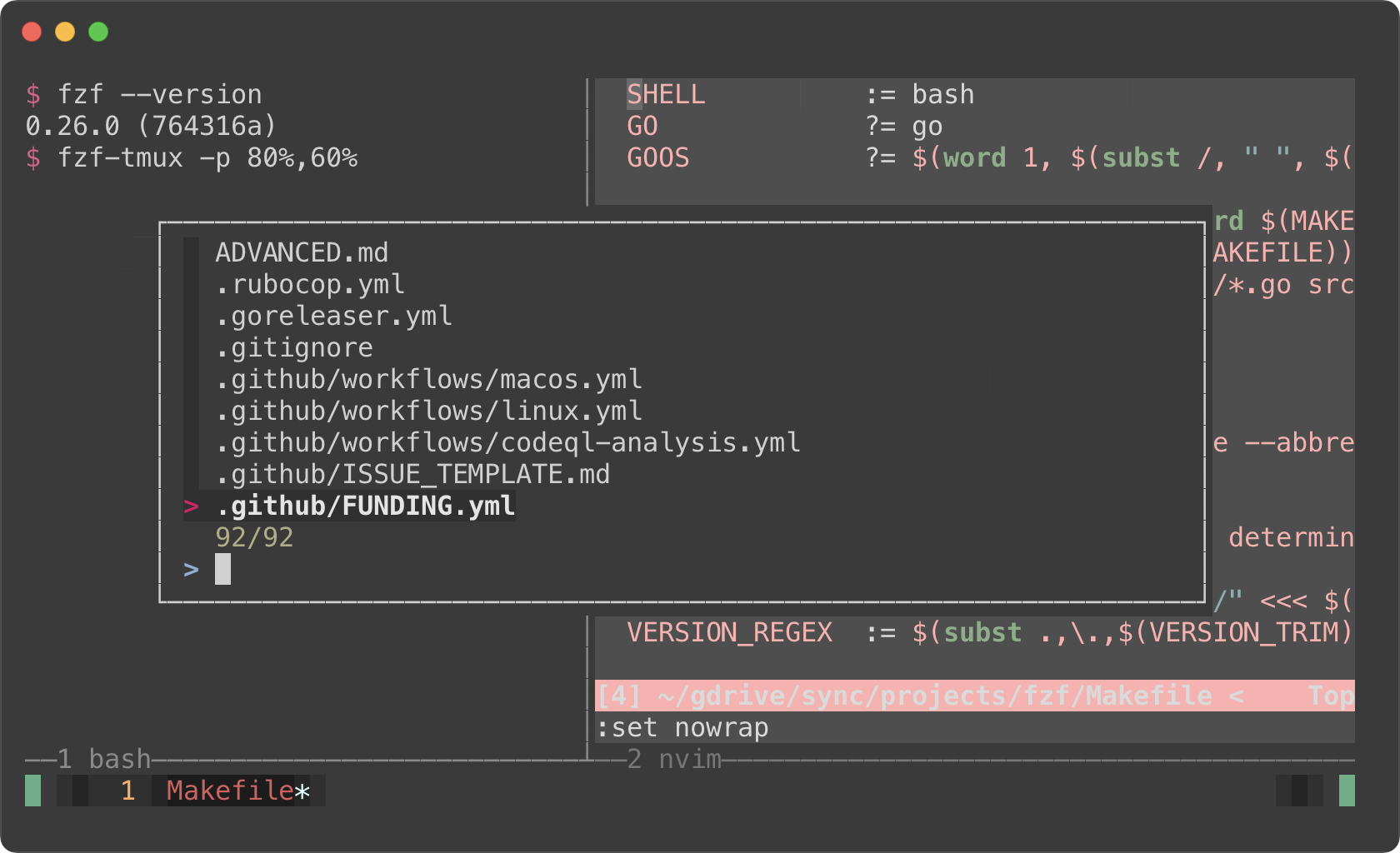
|
|
149
|
+
|
|
150
|
+
> You might also want to check out my tmux plugins which support this popup
|
|
151
|
+
> window layout.
|
|
152
|
+
>
|
|
153
|
+
> - https://github.com/junegunn/tmux-fzf-url
|
|
154
|
+
> - https://github.com/junegunn/tmux-fzf-maccy
|
|
155
|
+
|
|
156
|
+
Dynamic reloading of the list
|
|
157
|
+
-----------------------------
|
|
158
|
+
|
|
159
|
+
fzf can dynamically update the candidate list using an arbitrary program with
|
|
160
|
+
`reload` bindings (The design document for `reload` can be found
|
|
161
|
+
[here][reload]).
|
|
162
|
+
|
|
163
|
+
[reload]: https://github.com/junegunn/fzf/issues/1750
|
|
164
|
+
|
|
165
|
+
### Updating the list of processes by pressing CTRL-R
|
|
166
|
+
|
|
167
|
+
This example shows how you can set up a binding for dynamically updating the
|
|
168
|
+
list without restarting fzf.
|
|
169
|
+
|
|
170
|
+
```sh
|
|
171
|
+
(date; ps -ef) |
|
|
172
|
+
fzf --bind='ctrl-r:reload(date; ps -ef)' \
|
|
173
|
+
--header=$'Press CTRL-R to reload\n\n' --header-lines=2 \
|
|
174
|
+
--preview='echo {}' --preview-window=down,3,wrap \
|
|
175
|
+
--layout=reverse --height=80% | awk '{print $2}' | xargs kill -9
|
|
176
|
+
```
|
|
177
|
+
|
|
178
|
+
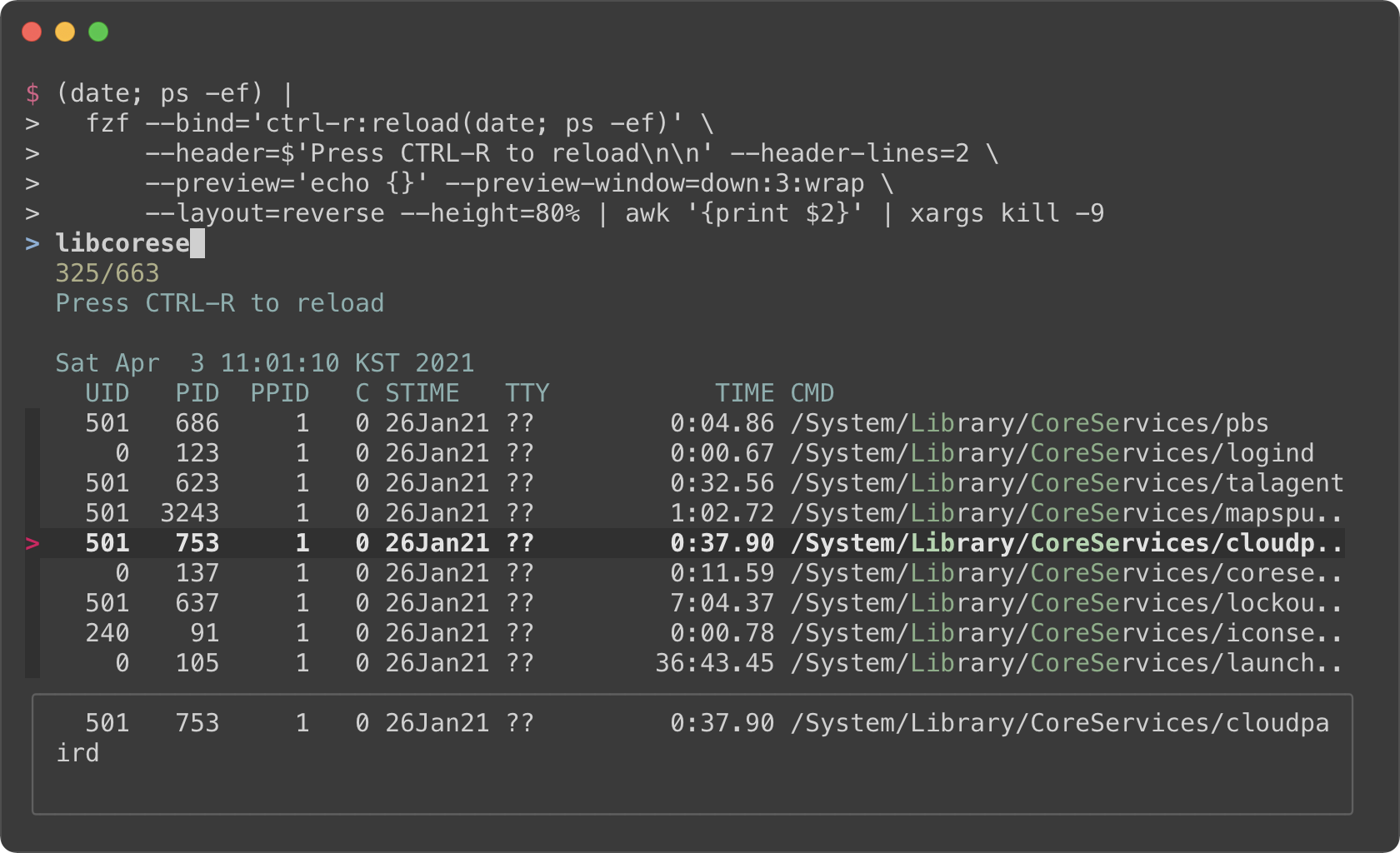
|
|
179
|
+
|
|
180
|
+
- The initial command is `(date; ps -ef)`. It prints the current date and
|
|
181
|
+
time, and the list of the processes.
|
|
182
|
+
- With `--header` option, you can show any message as the fixed header.
|
|
183
|
+
- To disallow selecting the first two lines (`date` and `ps` header), we use
|
|
184
|
+
`--header-lines=2` option.
|
|
185
|
+
- `--bind='ctrl-r:reload(date; ps -ef)'` binds CTRL-R to `reload` action that
|
|
186
|
+
runs `date; ps -ef`, so we can update the list of the processes by pressing
|
|
187
|
+
CTRL-R.
|
|
188
|
+
- We use simple `echo {}` preview option, so we can see the entire line on the
|
|
189
|
+
preview window below even if it's too long
|
|
190
|
+
|
|
191
|
+
### Toggling between data sources
|
|
192
|
+
|
|
193
|
+
You're not limited to just one reload binding. Set up multiple bindings so
|
|
194
|
+
you can switch between data sources.
|
|
195
|
+
|
|
196
|
+
```sh
|
|
197
|
+
find * | fzf --prompt 'All> ' \
|
|
198
|
+
--header 'CTRL-D: Directories / CTRL-F: Files' \
|
|
199
|
+
--bind 'ctrl-d:change-prompt(Directories> )+reload(find * -type d)' \
|
|
200
|
+
--bind 'ctrl-f:change-prompt(Files> )+reload(find * -type f)'
|
|
201
|
+
```
|
|
202
|
+
|
|
203
|
+
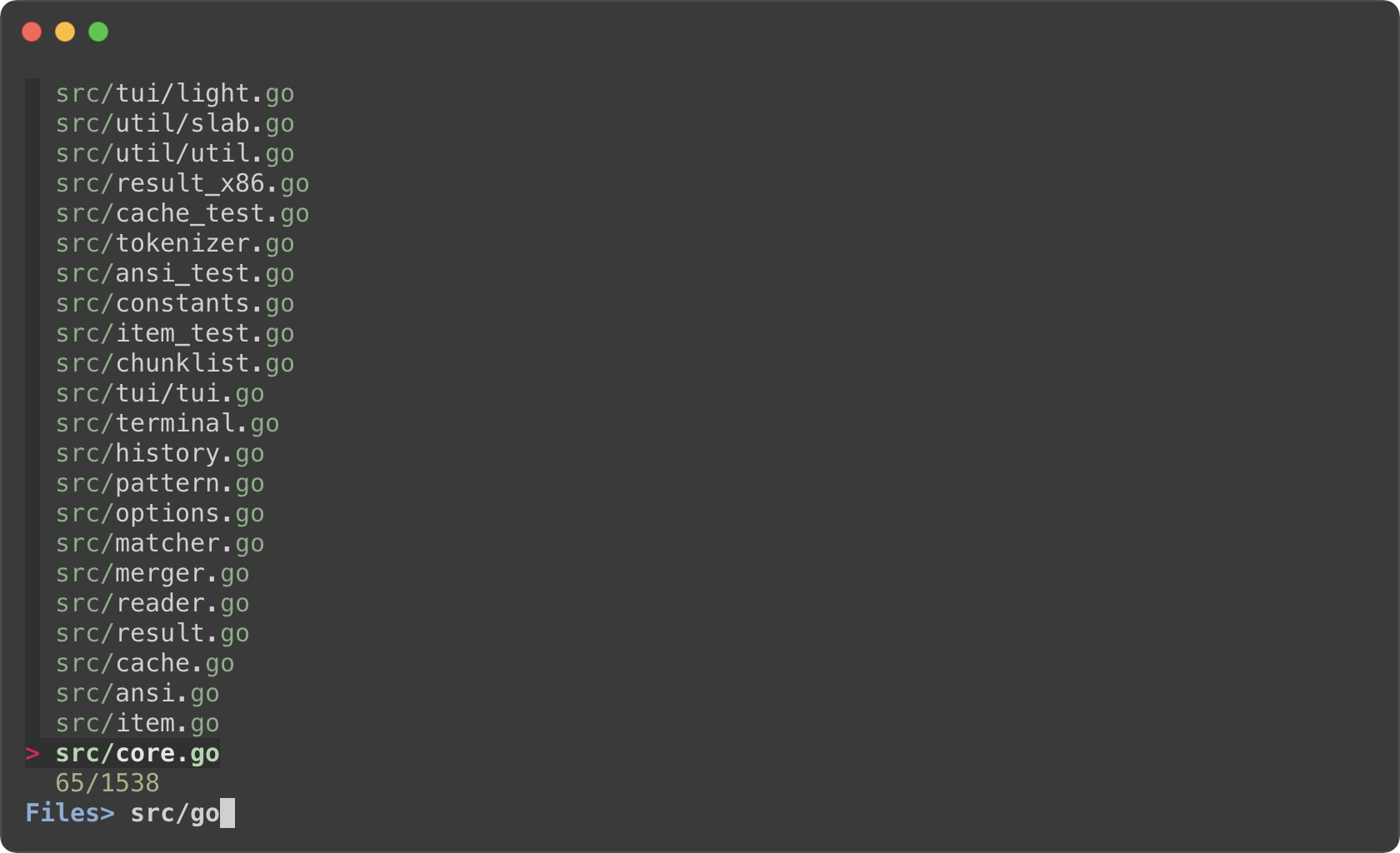
|
|
204
|
+
|
|
205
|
+
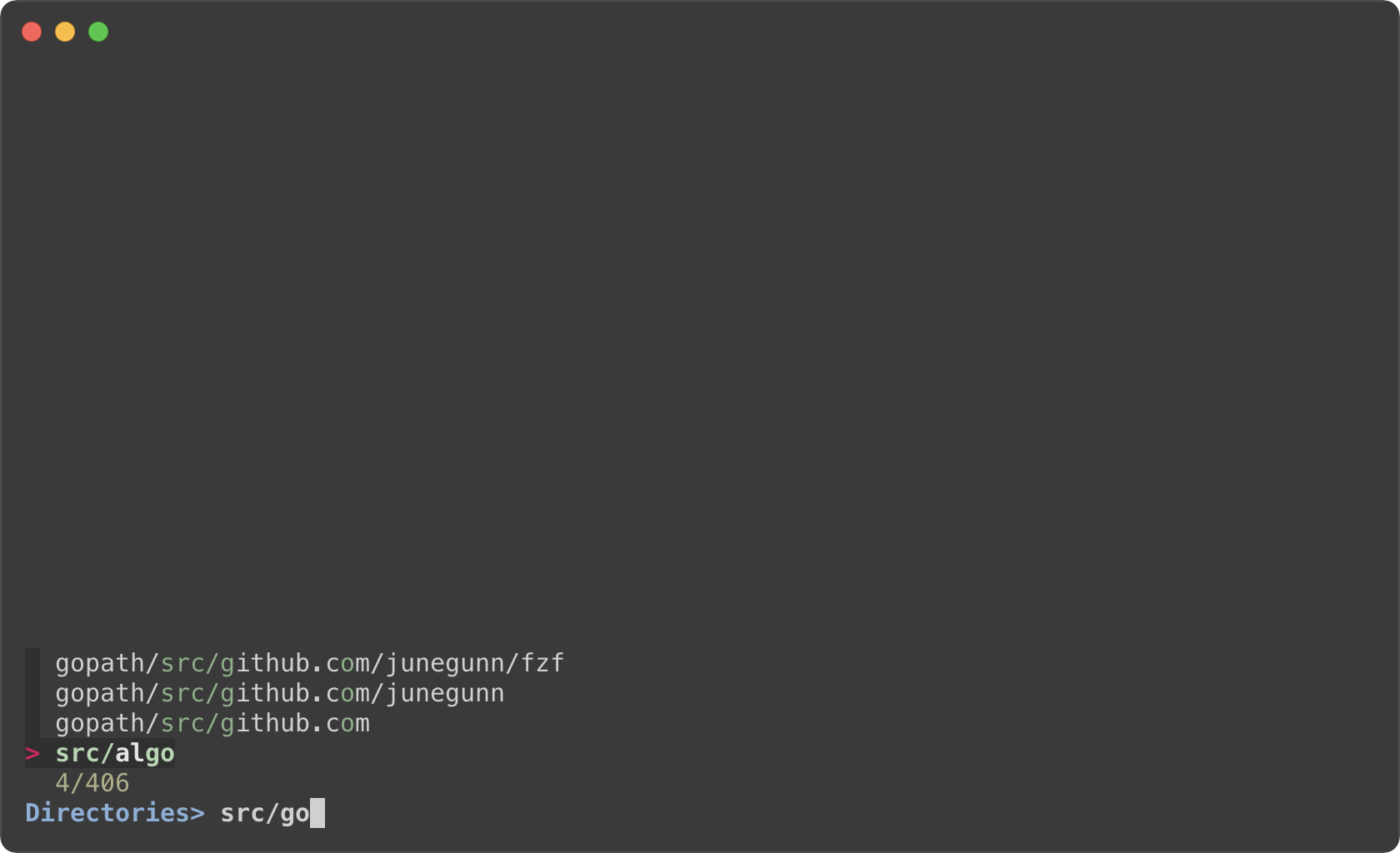
|
|
206
|
+
|
|
207
|
+
Ripgrep integration
|
|
208
|
+
-------------------
|
|
209
|
+
|
|
210
|
+
### Using fzf as the secondary filter
|
|
211
|
+
|
|
212
|
+
* Requires [bat][bat]
|
|
213
|
+
* Requires [Ripgrep][rg]
|
|
214
|
+
|
|
215
|
+
[bat]: https://github.com/sharkdp/bat
|
|
216
|
+
[rg]: https://github.com/BurntSushi/ripgrep
|
|
217
|
+
|
|
218
|
+
fzf is pretty fast for filtering a list that you will rarely have to think
|
|
219
|
+
about its performance. But it is not the right tool for searching for text
|
|
220
|
+
inside many large files, and in that case you should definitely use something
|
|
221
|
+
like [Ripgrep][rg].
|
|
222
|
+
|
|
223
|
+
In the next example, Ripgrep is the primary filter that searches for the given
|
|
224
|
+
text in files, and fzf is used as the secondary fuzzy filter that adds
|
|
225
|
+
interactivity to the workflow. And we use [bat][bat] to show the matching line in
|
|
226
|
+
the preview window.
|
|
227
|
+
|
|
228
|
+
This is a bash script and it will not run as expected on other non-compliant
|
|
229
|
+
shells. To avoid the compatibility issue, let's save this snippet as a script
|
|
230
|
+
file called `rfv`.
|
|
231
|
+
|
|
232
|
+
```bash
|
|
233
|
+
#!/usr/bin/env bash
|
|
234
|
+
|
|
235
|
+
# 1. Search for text in files using Ripgrep
|
|
236
|
+
# 2. Interactively narrow down the list using fzf
|
|
237
|
+
# 3. Open the file in Vim
|
|
238
|
+
IFS=: read -ra selected < <(
|
|
239
|
+
rg --color=always --line-number --no-heading --smart-case "${*:-}" |
|
|
240
|
+
fzf --ansi \
|
|
241
|
+
--color "hl:-1:underline,hl+:-1:underline:reverse" \
|
|
242
|
+
--delimiter : \
|
|
243
|
+
--preview 'bat --color=always {1} --highlight-line {2}' \
|
|
244
|
+
--preview-window 'up,60%,border-bottom,+{2}+3/3,~3'
|
|
245
|
+
)
|
|
246
|
+
[ -n "${selected[0]}" ] && vim "${selected[0]}" "+${selected[1]}"
|
|
247
|
+
```
|
|
248
|
+
|
|
249
|
+
And run it with an initial query string.
|
|
250
|
+
|
|
251
|
+
```sh
|
|
252
|
+
# Make the script executable
|
|
253
|
+
chmod +x rfv
|
|
254
|
+
|
|
255
|
+
# Run it with the initial query "algo"
|
|
256
|
+
./rfv algo
|
|
257
|
+
```
|
|
258
|
+
|
|
259
|
+
> Ripgrep will perform the initial search and list all the lines that contain
|
|
260
|
+
`algo`. Then we further narrow down the list on fzf.
|
|
261
|
+
|
|
262
|
+
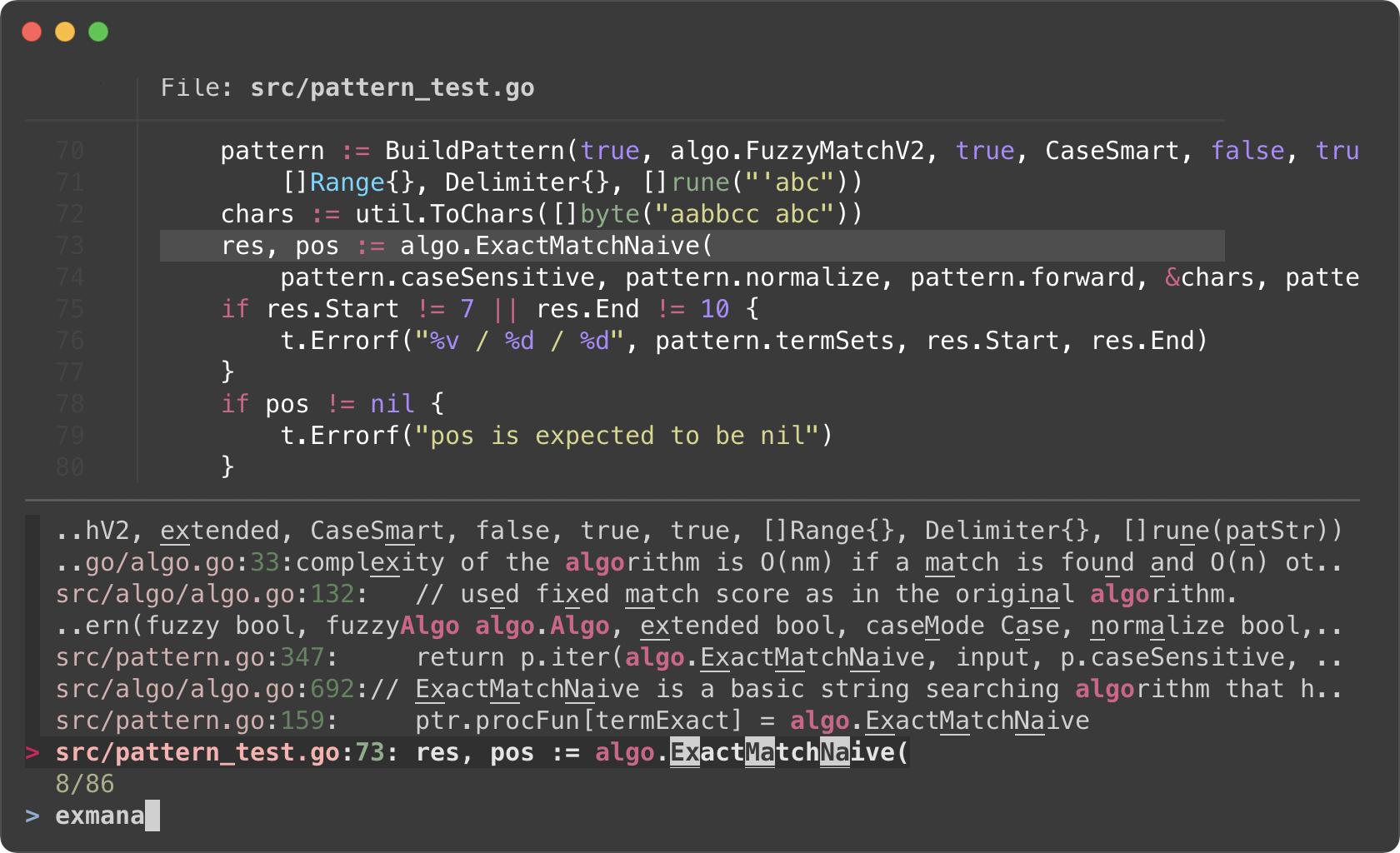
|
|
263
|
+
|
|
264
|
+
I know it's a lot to digest, let's try to break down the code.
|
|
265
|
+
|
|
266
|
+
- Ripgrep prints the matching lines in the following format
|
|
267
|
+
```
|
|
268
|
+
man/man1/fzf.1:54:.BI "--algo=" TYPE
|
|
269
|
+
man/man1/fzf.1:55:Fuzzy matching algorithm (default: v2)
|
|
270
|
+
man/man1/fzf.1:58:.BR v2 " Optimal scoring algorithm (quality)"
|
|
271
|
+
src/pattern_test.go:7: "github.com/junegunn/fzf/src/algo"
|
|
272
|
+
```
|
|
273
|
+
The first token delimited by `:` is the file path, and the second token is
|
|
274
|
+
the line number of the matching line. They respectively correspond to `{1}`
|
|
275
|
+
and `{2}` in the preview command.
|
|
276
|
+
- `--preview 'bat --color=always {1} --highlight-line {2}'`
|
|
277
|
+
- As we run `rg` with `--color=always` option, we should tell fzf to parse
|
|
278
|
+
ANSI color codes in the input by setting `--ansi`.
|
|
279
|
+
- We customize how fzf colors various text elements using `--color` option.
|
|
280
|
+
`-1` tells fzf to keep the original color from the input. See `man fzf` for
|
|
281
|
+
available color options.
|
|
282
|
+
- The value of `--preview-window` option consists of 5 components delimited
|
|
283
|
+
by `,`
|
|
284
|
+
1. `up` — Position of the preview window
|
|
285
|
+
1. `60%` — Size of the preview window
|
|
286
|
+
1. `border-bottom` — Preview window border only on the bottom side
|
|
287
|
+
1. `+{2}+3/3` — Scroll offset of the preview contents
|
|
288
|
+
1. `~3` — Fixed header
|
|
289
|
+
- Let's break down the latter two. We want to display the bat output in the
|
|
290
|
+
preview window with a certain scroll offset so that the matching line is
|
|
291
|
+
positioned near the center of the preview window.
|
|
292
|
+
- `+{2}` — The base offset is extracted from the second token
|
|
293
|
+
- `+3` — We add 3 lines to the base offset to compensate for the header
|
|
294
|
+
part of `bat` output
|
|
295
|
+
- ```
|
|
296
|
+
───────┬──────────────────────────────────────────────────────────
|
|
297
|
+
│ File: CHANGELOG.md
|
|
298
|
+
───────┼──────────────────────────────────────────────────────────
|
|
299
|
+
1 │ CHANGELOG
|
|
300
|
+
2 │ =========
|
|
301
|
+
3 │
|
|
302
|
+
4 │ 0.26.0
|
|
303
|
+
5 │ ------
|
|
304
|
+
```
|
|
305
|
+
- `/3` adjusts the offset so that the matching line is shown at a third
|
|
306
|
+
position in the window
|
|
307
|
+
- `~3` makes the top three lines fixed header so that they are always
|
|
308
|
+
visible regardless of the scroll offset
|
|
309
|
+
- Once we selected a line, we open the file with `vim` (`vim
|
|
310
|
+
"${selected[0]}"`) and move the cursor to the line (`+${selected[1]}`).
|
|
311
|
+
|
|
312
|
+
### Using fzf as interative Ripgrep launcher
|
|
313
|
+
|
|
314
|
+
We have learned that we can bind `reload` action to a key (e.g.
|
|
315
|
+
`--bind=ctrl-r:execute(ps -ef)`). In the next example, we are going to **bind
|
|
316
|
+
`reload` action to `change` event** so that whenever the user *changes* the
|
|
317
|
+
query string on fzf, `reload` action is triggered.
|
|
318
|
+
|
|
319
|
+
Here is a variation of the above `rfv` script. fzf will restart Ripgrep every
|
|
320
|
+
time the user updates the query string on fzf. Searching and filtering is
|
|
321
|
+
completely done by Ripgrep, and fzf merely provides the interactive interface.
|
|
322
|
+
So we lose the "fuzziness", but the performance will be better on larger
|
|
323
|
+
projects, and it will free up memory as you narrow down the results.
|
|
324
|
+
|
|
325
|
+
```bash
|
|
326
|
+
#!/usr/bin/env bash
|
|
327
|
+
|
|
328
|
+
# 1. Search for text in files using Ripgrep
|
|
329
|
+
# 2. Interactively restart Ripgrep with reload action
|
|
330
|
+
# 3. Open the file in Vim
|
|
331
|
+
RG_PREFIX="rg --column --line-number --no-heading --color=always --smart-case "
|
|
332
|
+
INITIAL_QUERY="${*:-}"
|
|
333
|
+
IFS=: read -ra selected < <(
|
|
334
|
+
FZF_DEFAULT_COMMAND="$RG_PREFIX $(printf %q "$INITIAL_QUERY")" \
|
|
335
|
+
fzf --ansi \
|
|
336
|
+
--disabled --query "$INITIAL_QUERY" \
|
|
337
|
+
--bind "change:reload:sleep 0.1; $RG_PREFIX {q} || true" \
|
|
338
|
+
--delimiter : \
|
|
339
|
+
--preview 'bat --color=always {1} --highlight-line {2}' \
|
|
340
|
+
--preview-window 'up,60%,border-bottom,+{2}+3/3,~3'
|
|
341
|
+
)
|
|
342
|
+
[ -n "${selected[0]}" ] && vim "${selected[0]}" "+${selected[1]}"
|
|
343
|
+
```
|
|
344
|
+
|
|
345
|
+
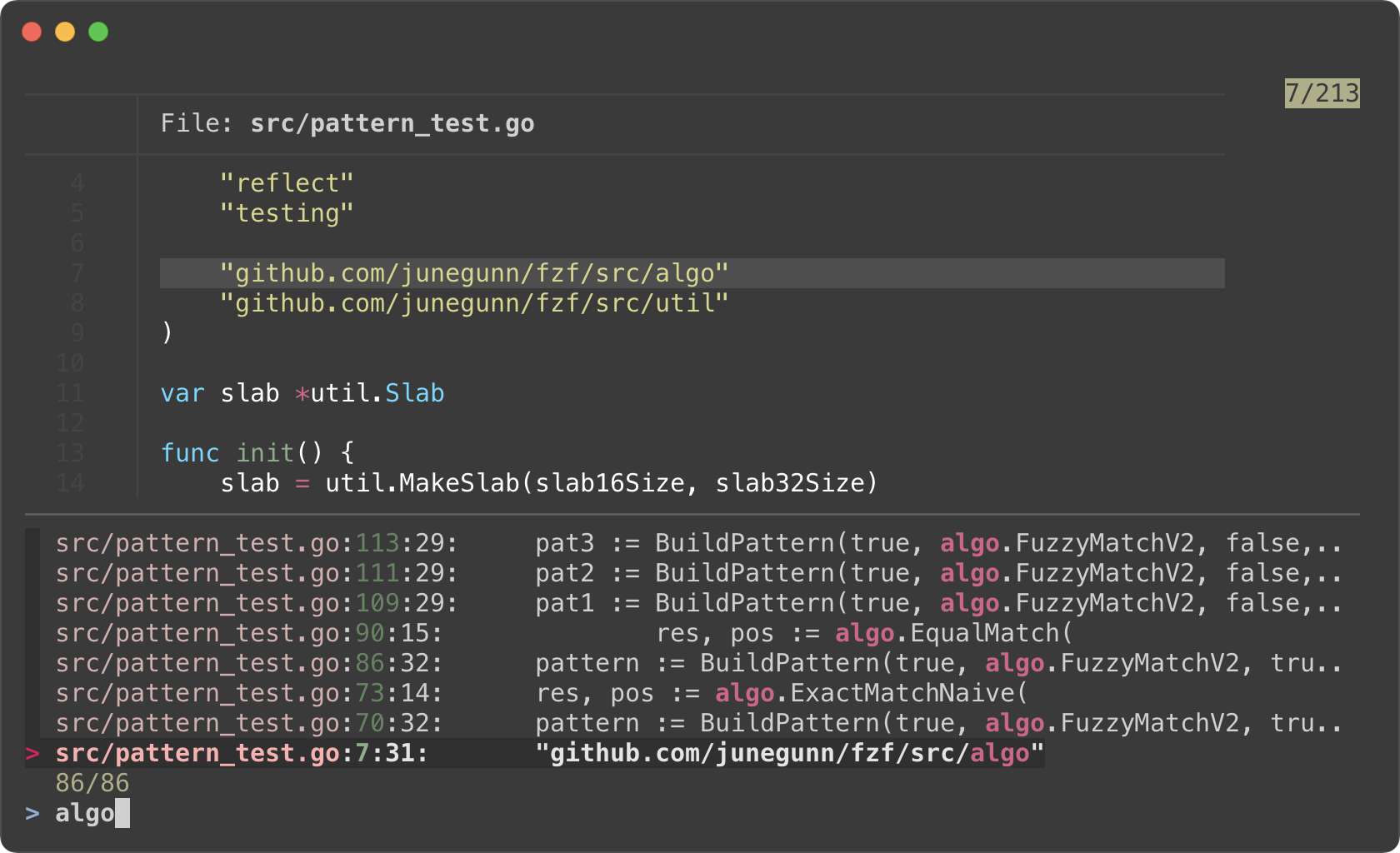
|
|
346
|
+
|
|
347
|
+
- Instead of starting fzf in `rg ... | fzf` form, we start fzf without an
|
|
348
|
+
explicit input, but with a custom `FZF_DEFAULT_COMMAND` variable. This way
|
|
349
|
+
fzf can kill the initial Ripgrep process it starts with the initial query.
|
|
350
|
+
Otherwise, the initial Ripgrep process will keep consuming system resources
|
|
351
|
+
even after `reload` is triggered.
|
|
352
|
+
- Filtering is no longer a responsibility of fzf; hence `--disabled`
|
|
353
|
+
- `{q}` in the reload command evaluates to the query string on fzf prompt.
|
|
354
|
+
- `sleep 0.1` in the reload command is for "debouncing". This small delay will
|
|
355
|
+
reduce the number of intermediate Ripgrep processes while we're typing in
|
|
356
|
+
a query.
|
|
357
|
+
|
|
358
|
+
### Switching to fzf-only search mode
|
|
359
|
+
|
|
360
|
+
*(Requires fzf 0.27.1 or above)*
|
|
361
|
+
|
|
362
|
+
In the previous example, we lost fuzzy matching capability as we completely
|
|
363
|
+
delegated search functionality to Ripgrep. But we can dynamically switch to
|
|
364
|
+
fzf-only search mode by *"unbinding"* `reload` action from `change` event.
|
|
365
|
+
|
|
366
|
+
```sh
|
|
367
|
+
#!/usr/bin/env bash
|
|
368
|
+
|
|
369
|
+
# Two-phase filtering with Ripgrep and fzf
|
|
370
|
+
#
|
|
371
|
+
# 1. Search for text in files using Ripgrep
|
|
372
|
+
# 2. Interactively restart Ripgrep with reload action
|
|
373
|
+
# * Press alt-enter to switch to fzf-only filtering
|
|
374
|
+
# 3. Open the file in Vim
|
|
375
|
+
RG_PREFIX="rg --column --line-number --no-heading --color=always --smart-case "
|
|
376
|
+
INITIAL_QUERY="${*:-}"
|
|
377
|
+
IFS=: read -ra selected < <(
|
|
378
|
+
FZF_DEFAULT_COMMAND="$RG_PREFIX $(printf %q "$INITIAL_QUERY")" \
|
|
379
|
+
fzf --ansi \
|
|
380
|
+
--color "hl:-1:underline,hl+:-1:underline:reverse" \
|
|
381
|
+
--disabled --query "$INITIAL_QUERY" \
|
|
382
|
+
--bind "change:reload:sleep 0.1; $RG_PREFIX {q} || true" \
|
|
383
|
+
--bind "alt-enter:unbind(change,alt-enter)+change-prompt(2. fzf> )+enable-search+clear-query" \
|
|
384
|
+
--prompt '1. ripgrep> ' \
|
|
385
|
+
--delimiter : \
|
|
386
|
+
--preview 'bat --color=always {1} --highlight-line {2}' \
|
|
387
|
+
--preview-window 'up,60%,border-bottom,+{2}+3/3,~3'
|
|
388
|
+
)
|
|
389
|
+
[ -n "${selected[0]}" ] && vim "${selected[0]}" "+${selected[1]}"
|
|
390
|
+
```
|
|
391
|
+
|
|
392
|
+
* Phase 1. Filtering with Ripgrep
|
|
393
|
+
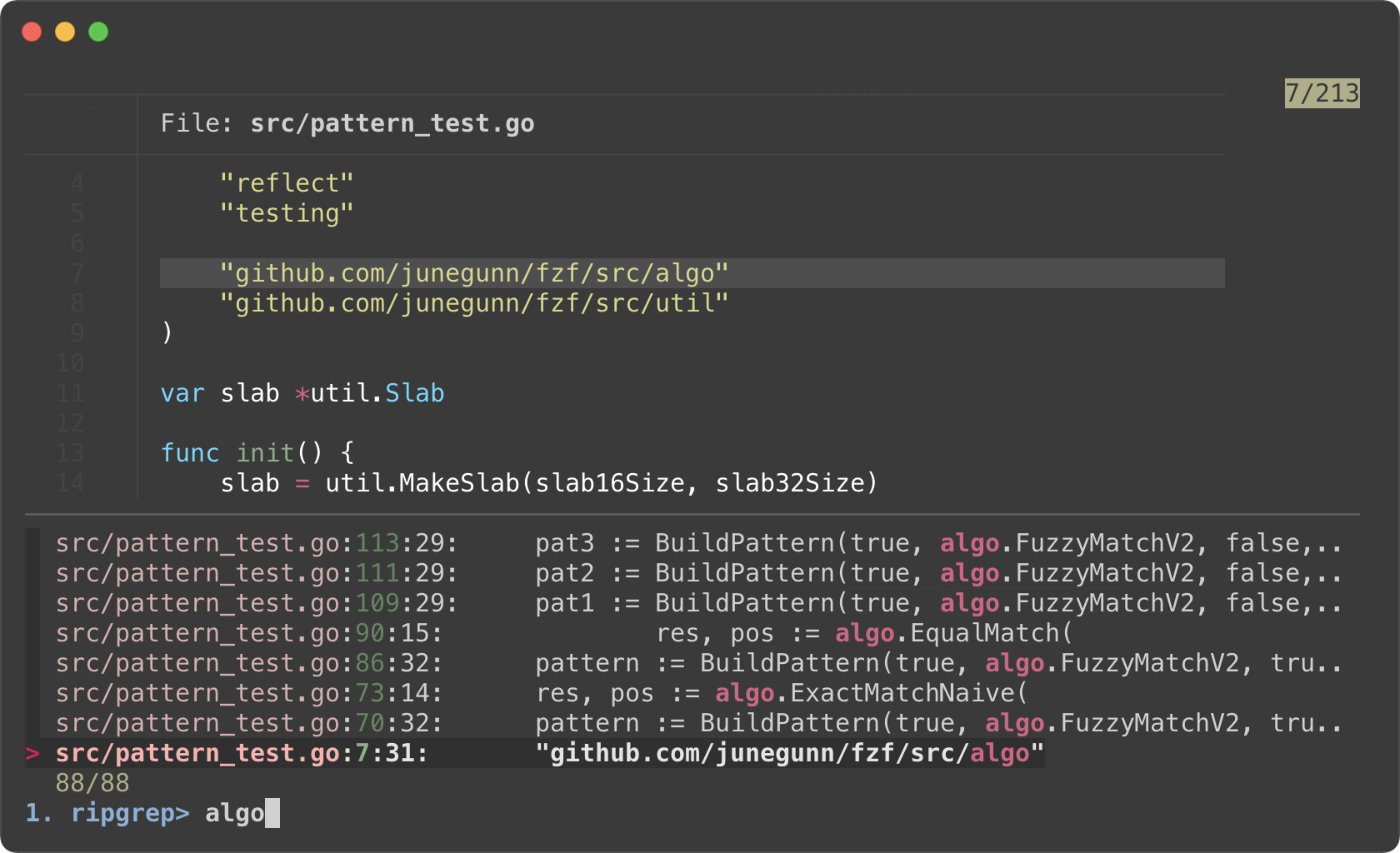
|
|
394
|
+
* Phase 2. Filtering with fzf
|
|
395
|
+
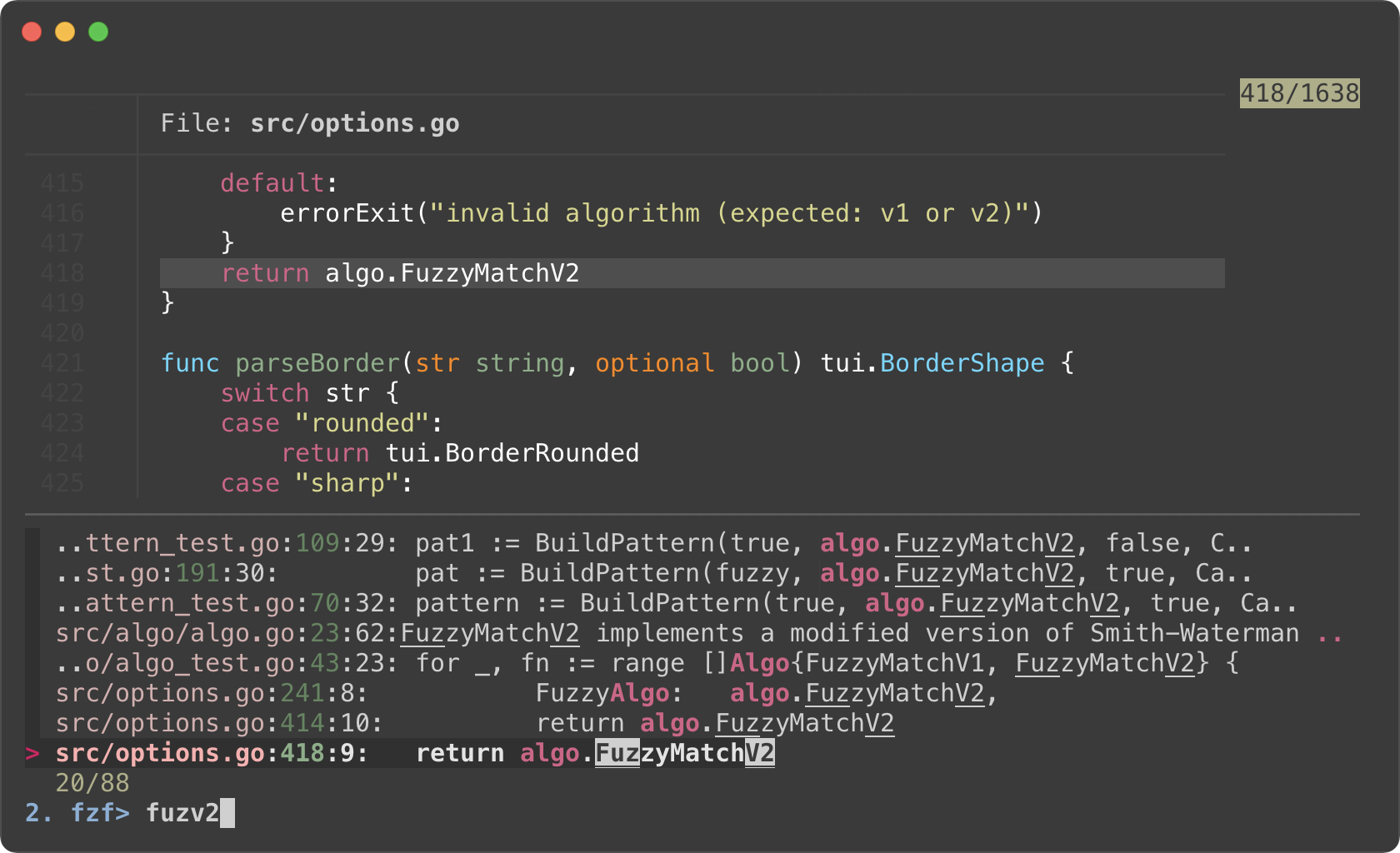
|
|
396
|
+
|
|
397
|
+
- We added `--prompt` option to show that fzf is initially running in "Ripgrep
|
|
398
|
+
launcher mode".
|
|
399
|
+
- We added `alt-enter` binding that
|
|
400
|
+
1. unbinds `change` event, so Ripgrep is no longer restarted on key press
|
|
401
|
+
2. changes the prompt to `2. fzf>`
|
|
402
|
+
3. enables search functionality of fzf
|
|
403
|
+
4. clears the current query string that was used to start Ripgrep process
|
|
404
|
+
5. and unbinds `alt-enter` itself as this is a one-off event
|
|
405
|
+
- We reverted `--color` option for customizing how the matching chunks are
|
|
406
|
+
displayed in the second phase
|
|
407
|
+
|
|
408
|
+
Log tailing
|
|
409
|
+
-----------
|
|
410
|
+
|
|
411
|
+
fzf can run long-running preview commands and render partial results before
|
|
412
|
+
completion. And when you specify `follow` flag in `--preview-window` option,
|
|
413
|
+
fzf will "`tail -f`" the result, automatically scrolling to the bottom.
|
|
414
|
+
|
|
415
|
+
```bash
|
|
416
|
+
# With "follow", preview window will automatically scroll to the bottom.
|
|
417
|
+
# "\033[2J" is an ANSI escape sequence for clearing the screen.
|
|
418
|
+
# When fzf reads this code it clears the previous preview contents.
|
|
419
|
+
fzf --preview-window follow --preview 'for i in $(seq 100000); do
|
|
420
|
+
echo "$i"
|
|
421
|
+
sleep 0.01
|
|
422
|
+
(( i % 300 == 0 )) && printf "\033[2J"
|
|
423
|
+
done'
|
|
424
|
+
```
|
|
425
|
+
|
|
426
|
+
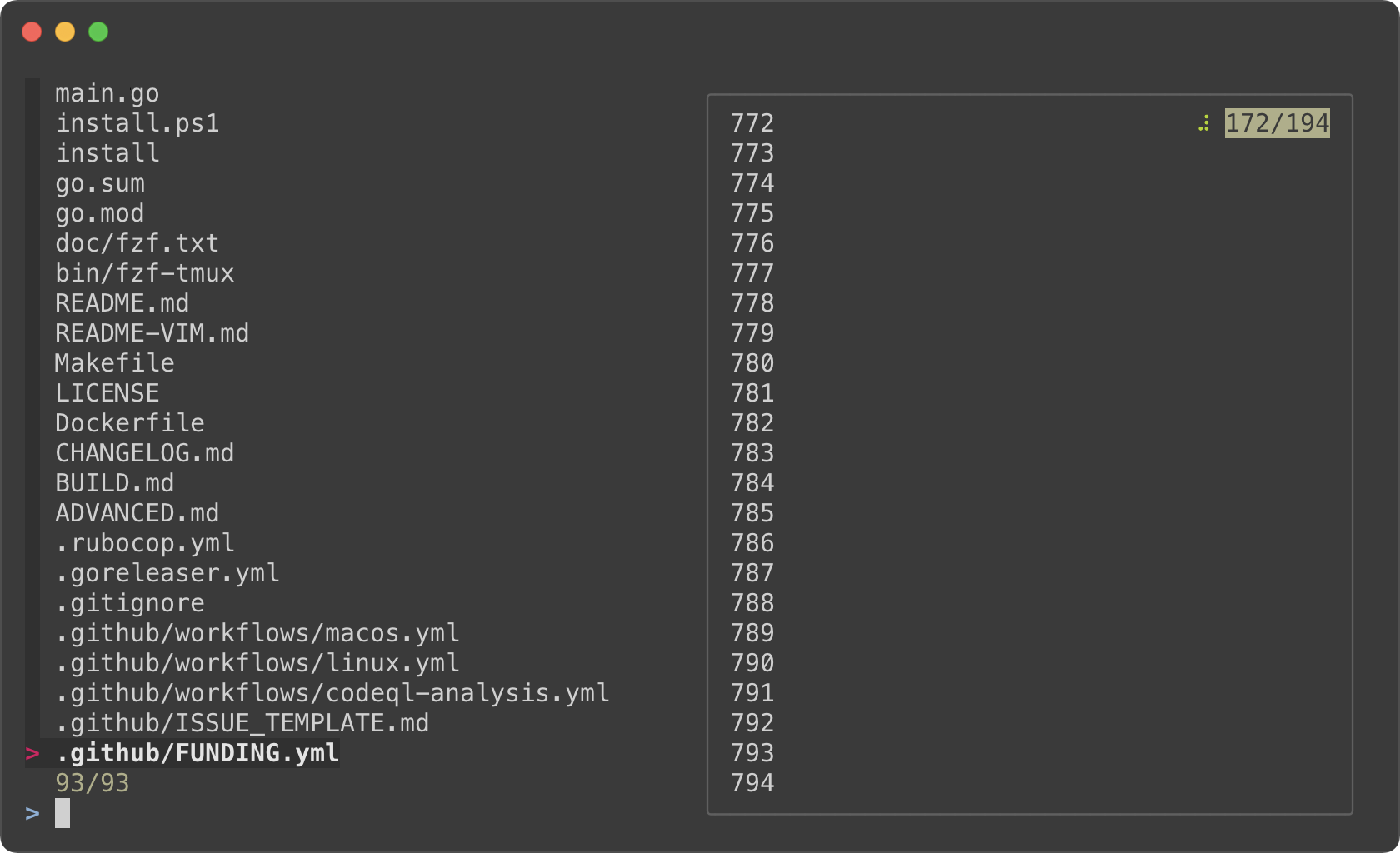
|
|
427
|
+
|
|
428
|
+
Admittedly, that was a silly example. Here's a practical one for browsing
|
|
429
|
+
Kubernetes pods.
|
|
430
|
+
|
|
431
|
+
```bash
|
|
432
|
+
#!/usr/bin/env bash
|
|
433
|
+
|
|
434
|
+
read -ra tokens < <(
|
|
435
|
+
kubectl get pods --all-namespaces |
|
|
436
|
+
fzf --info=inline --layout=reverse --header-lines=1 --border \
|
|
437
|
+
--prompt "$(kubectl config current-context | sed 's/-context$//')> " \
|
|
438
|
+
--header $'Press CTRL-O to open log in editor\n\n' \
|
|
439
|
+
--bind ctrl-/:toggle-preview \
|
|
440
|
+
--bind 'ctrl-o:execute:${EDITOR:-vim} <(kubectl logs --namespace {1} {2}) > /dev/tty' \
|
|
441
|
+
--preview-window up,follow \
|
|
442
|
+
--preview 'kubectl logs --follow --tail=100000 --namespace {1} {2}' "$@"
|
|
443
|
+
)
|
|
444
|
+
[ ${#tokens} -gt 1 ] &&
|
|
445
|
+
kubectl exec -it --namespace "${tokens[0]}" "${tokens[1]}" -- bash
|
|
446
|
+
```
|
|
447
|
+
|
|
448
|
+
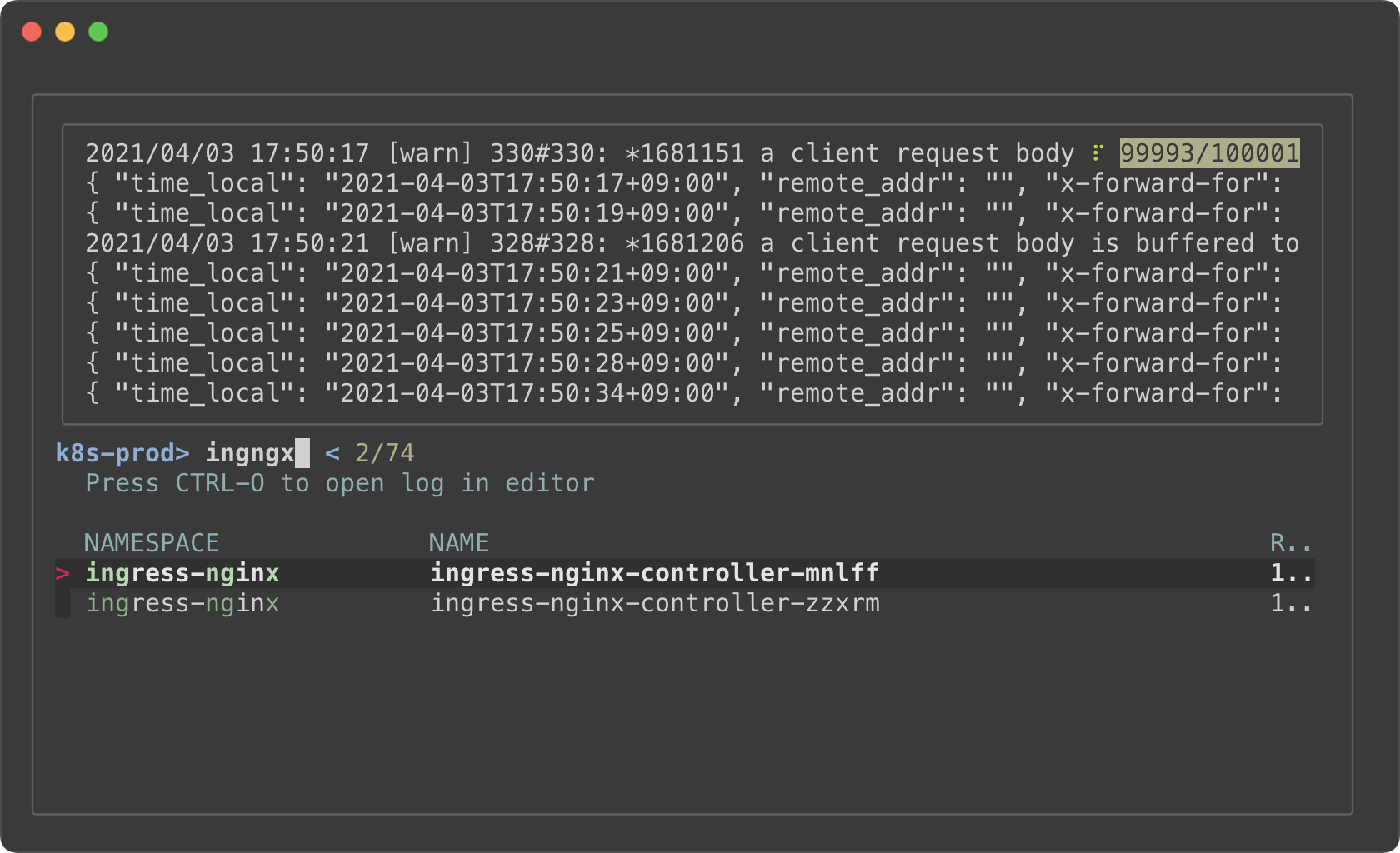
|
|
449
|
+
|
|
450
|
+
- The preview window will *"log tail"* the pod
|
|
451
|
+
- Holding on to a large amount of log will consume a lot of memory. So we
|
|
452
|
+
limited the initial log amount with `--tail=100000`.
|
|
453
|
+
- With `execute` binding, you can press CTRL-O to open the log in your editor
|
|
454
|
+
without leaving fzf
|
|
455
|
+
- Select a pod (with an enter key) to `kubectl exec` into it
|
|
456
|
+
|
|
457
|
+
Key bindings for git objects
|
|
458
|
+
----------------------------
|
|
459
|
+
|
|
460
|
+
I have [blogged](https://junegunn.kr/2016/07/fzf-git) about my fzf+git key
|
|
461
|
+
bindings a few years ago. I'm going to show them here again, because they are
|
|
462
|
+
seriously useful.
|
|
463
|
+
|
|
464
|
+
### Files listed in `git status`
|
|
465
|
+
|
|
466
|
+
<kbd>CTRL-G</kbd><kbd>CTRL-F</kbd>
|
|
467
|
+
|
|
468
|
+
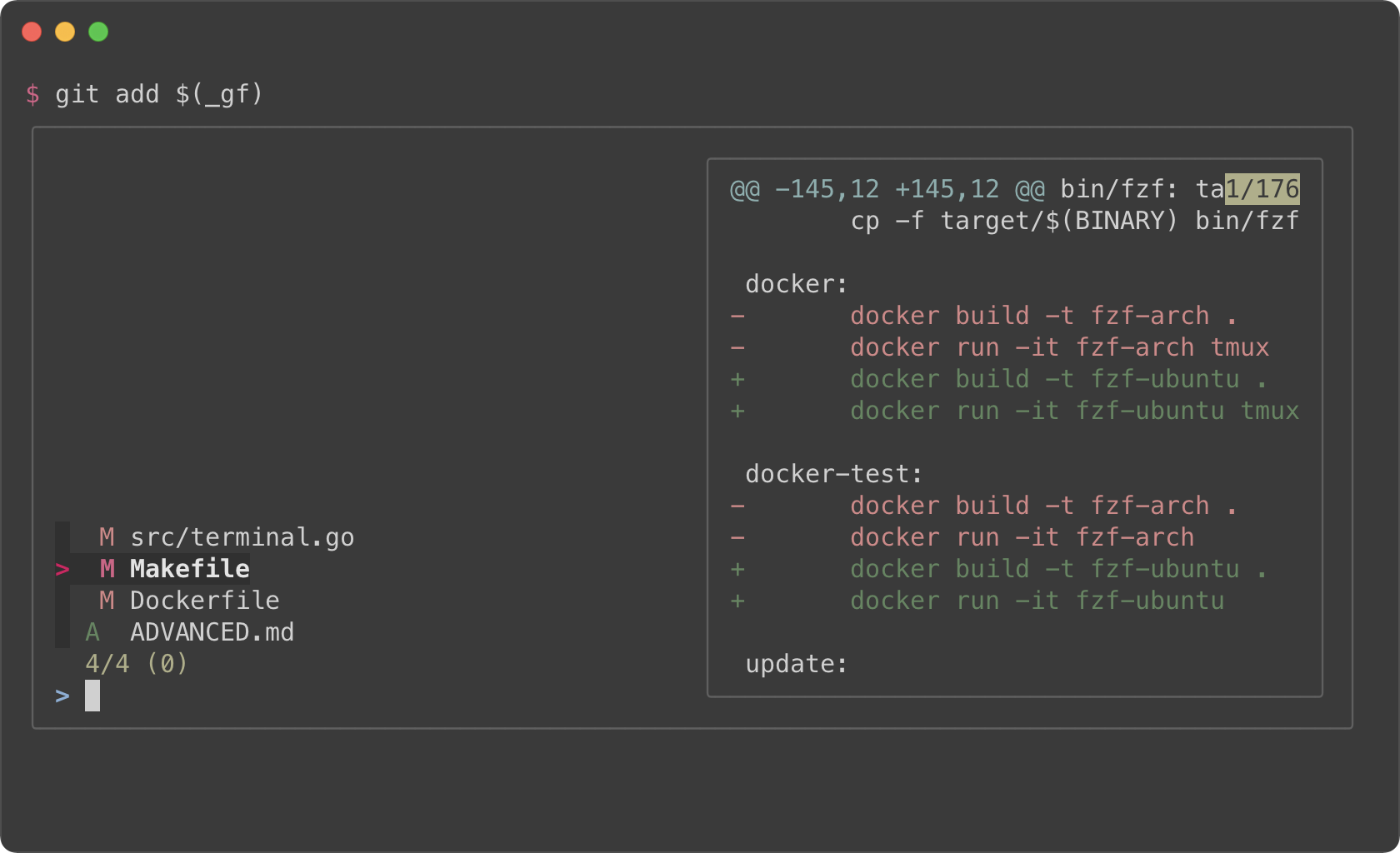
|
|
469
|
+
|
|
470
|
+
### Branches
|
|
471
|
+
|
|
472
|
+
<kbd>CTRL-G</kbd><kbd>CTRL-B</kbd>
|
|
473
|
+
|
|
474
|
+
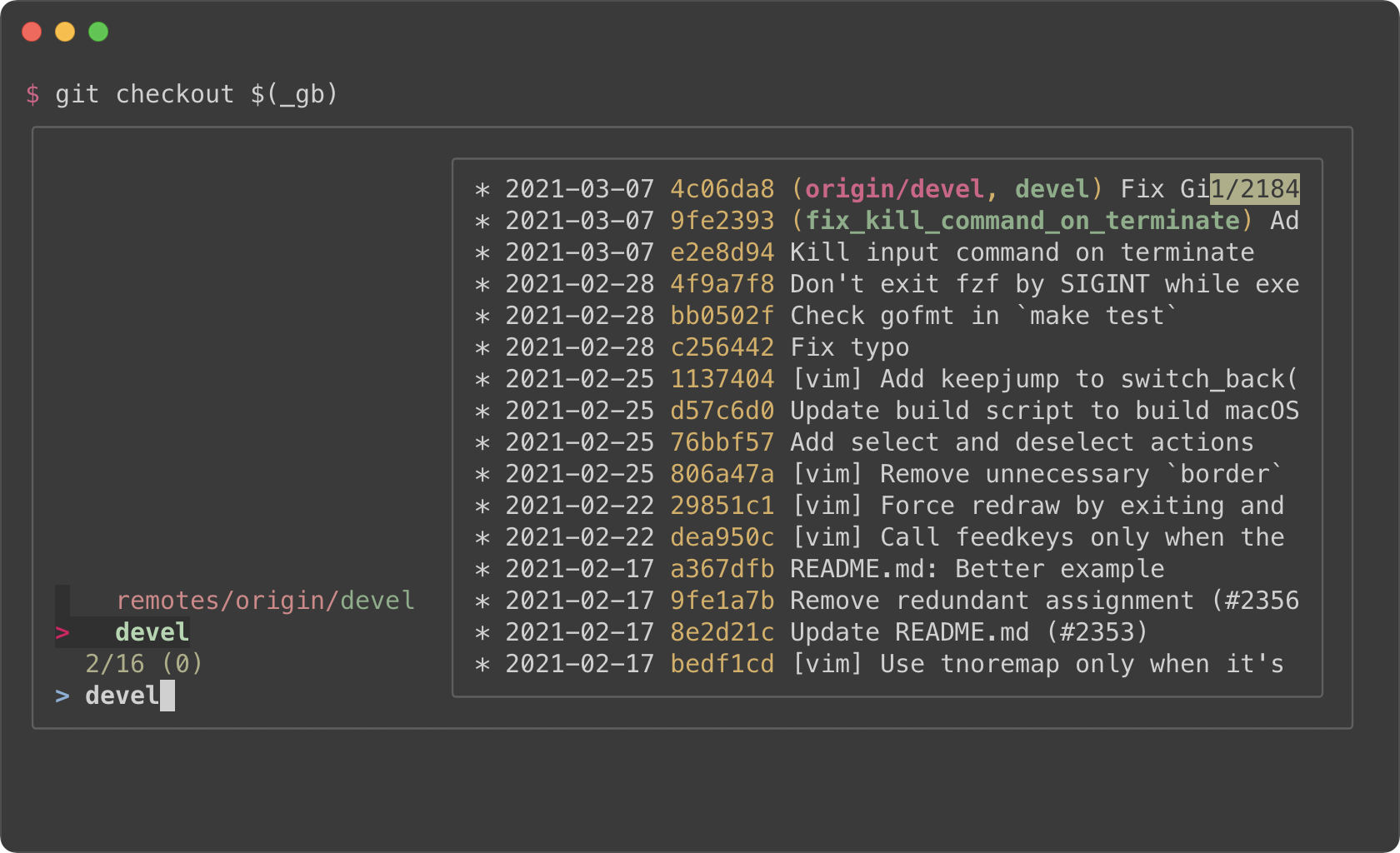
|
|
475
|
+
|
|
476
|
+
### Commit hashes
|
|
477
|
+
|
|
478
|
+
<kbd>CTRL-G</kbd><kbd>CTRL-H</kbd>
|
|
479
|
+
|
|
480
|
+
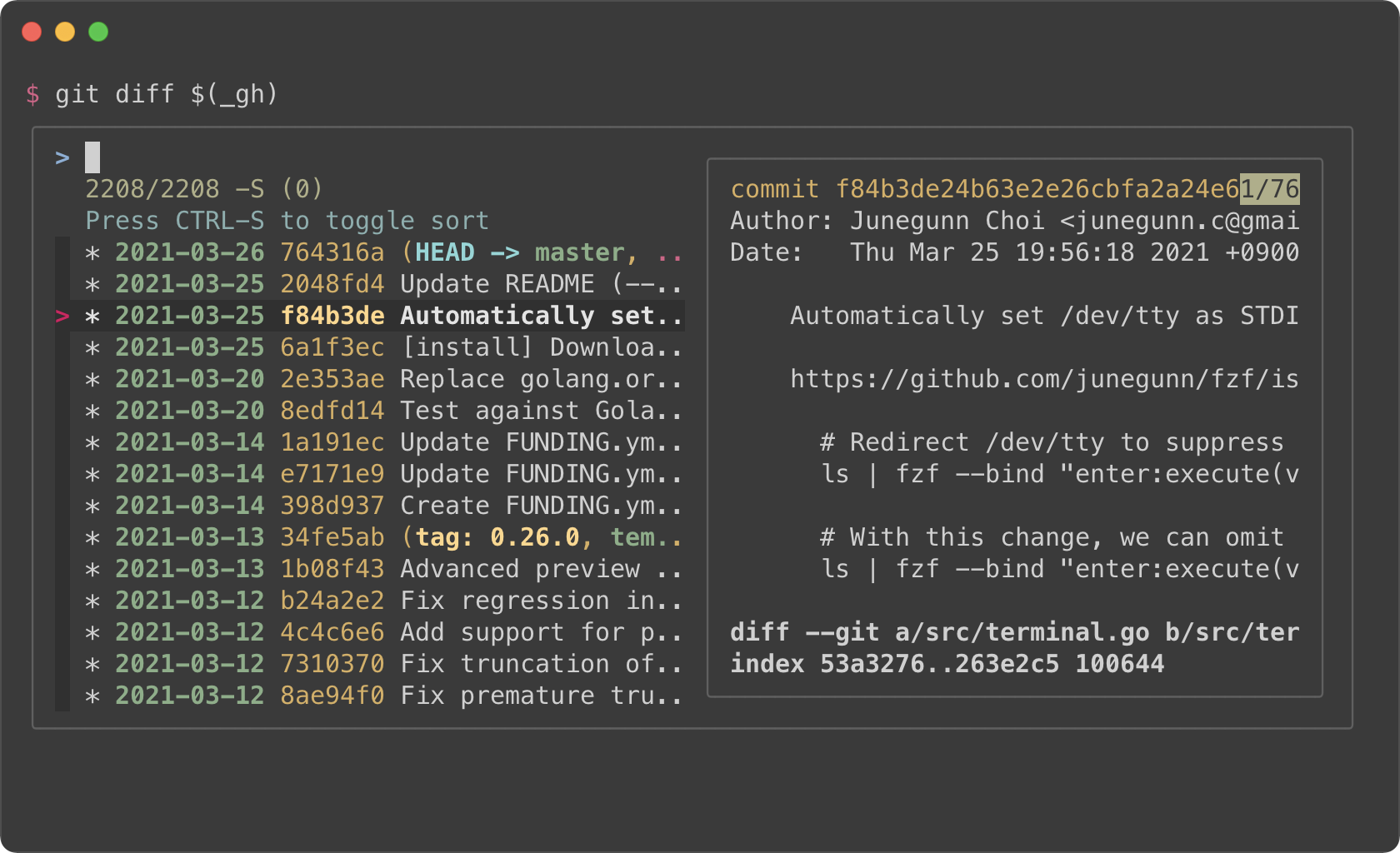
|
|
481
|
+
|
|
482
|
+
|
|
483
|
+
The full source code can be found [here](https://gist.github.com/junegunn/8b572b8d4b5eddd8b85e5f4d40f17236).
|
|
484
|
+
|
|
485
|
+
Color themes
|
|
486
|
+
------------
|
|
487
|
+
|
|
488
|
+
You can customize how fzf colors the text elements with `--color` option. Here
|
|
489
|
+
are a few color themes. Note that you need a terminal emulator that can
|
|
490
|
+
display 24-bit colors.
|
|
491
|
+
|
|
492
|
+
```sh
|
|
493
|
+
# junegunn/seoul256.vim (dark)
|
|
494
|
+
export FZF_DEFAULT_OPTS='--color=bg+:#3F3F3F,bg:#4B4B4B,border:#6B6B6B,spinner:#98BC99,hl:#719872,fg:#D9D9D9,header:#719872,info:#BDBB72,pointer:#E12672,marker:#E17899,fg+:#D9D9D9,preview-bg:#3F3F3F,prompt:#98BEDE,hl+:#98BC99'
|
|
495
|
+
```
|
|
496
|
+
|
|
497
|
+
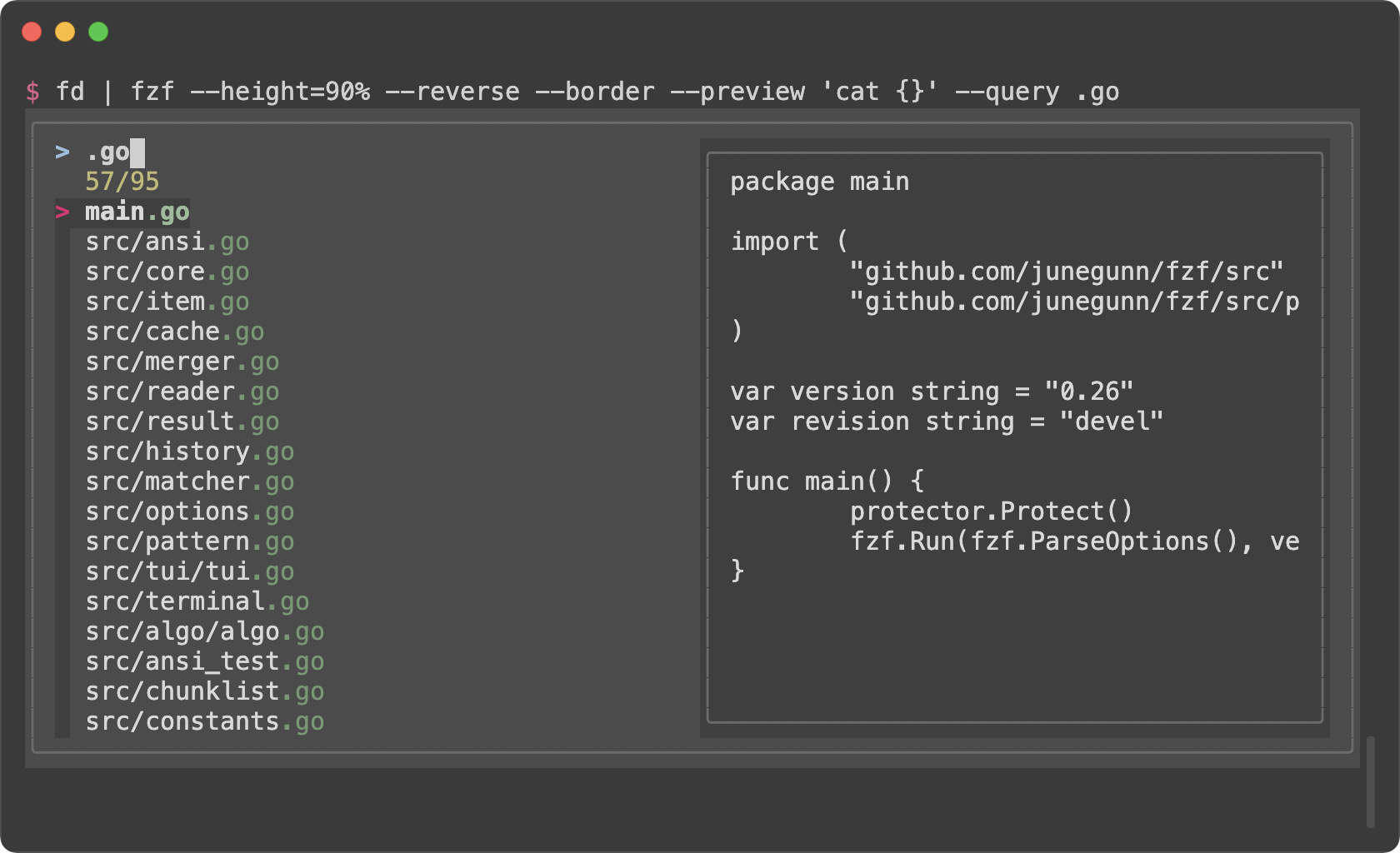
|
|
498
|
+
|
|
499
|
+
```sh
|
|
500
|
+
# junegunn/seoul256.vim (light)
|
|
501
|
+
export FZF_DEFAULT_OPTS='--color=bg+:#D9D9D9,bg:#E1E1E1,border:#C8C8C8,spinner:#719899,hl:#719872,fg:#616161,header:#719872,info:#727100,pointer:#E12672,marker:#E17899,fg+:#616161,preview-bg:#D9D9D9,prompt:#0099BD,hl+:#719899'
|
|
502
|
+
```
|
|
503
|
+
|
|
504
|
+
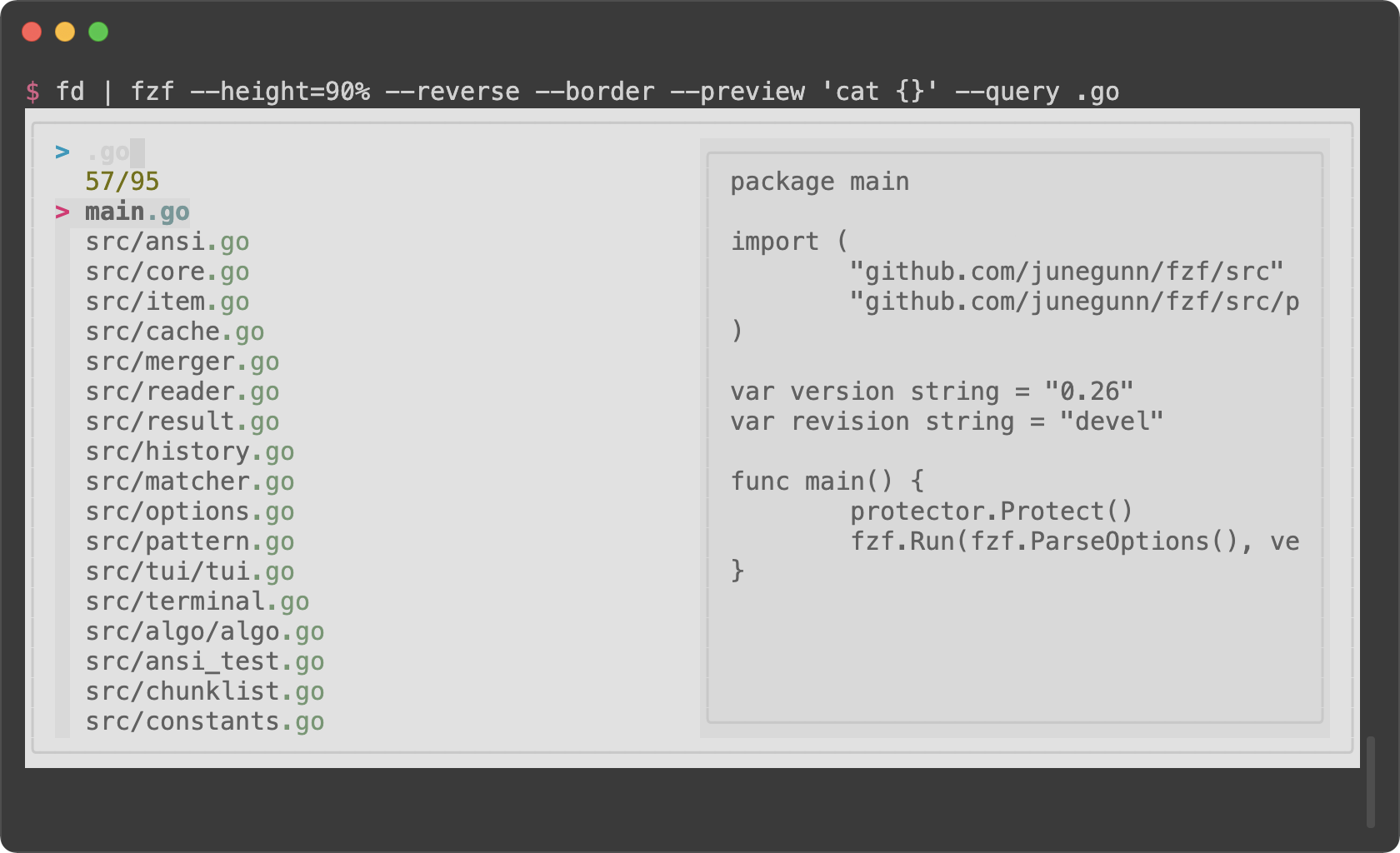
|
|
505
|
+
|
|
506
|
+
```sh
|
|
507
|
+
# morhetz/gruvbox
|
|
508
|
+
export FZF_DEFAULT_OPTS='--color=bg+:#3c3836,bg:#32302f,spinner:#fb4934,hl:#928374,fg:#ebdbb2,header:#928374,info:#8ec07c,pointer:#fb4934,marker:#fb4934,fg+:#ebdbb2,prompt:#fb4934,hl+:#fb4934'
|
|
509
|
+
```
|
|
510
|
+
|
|
511
|
+
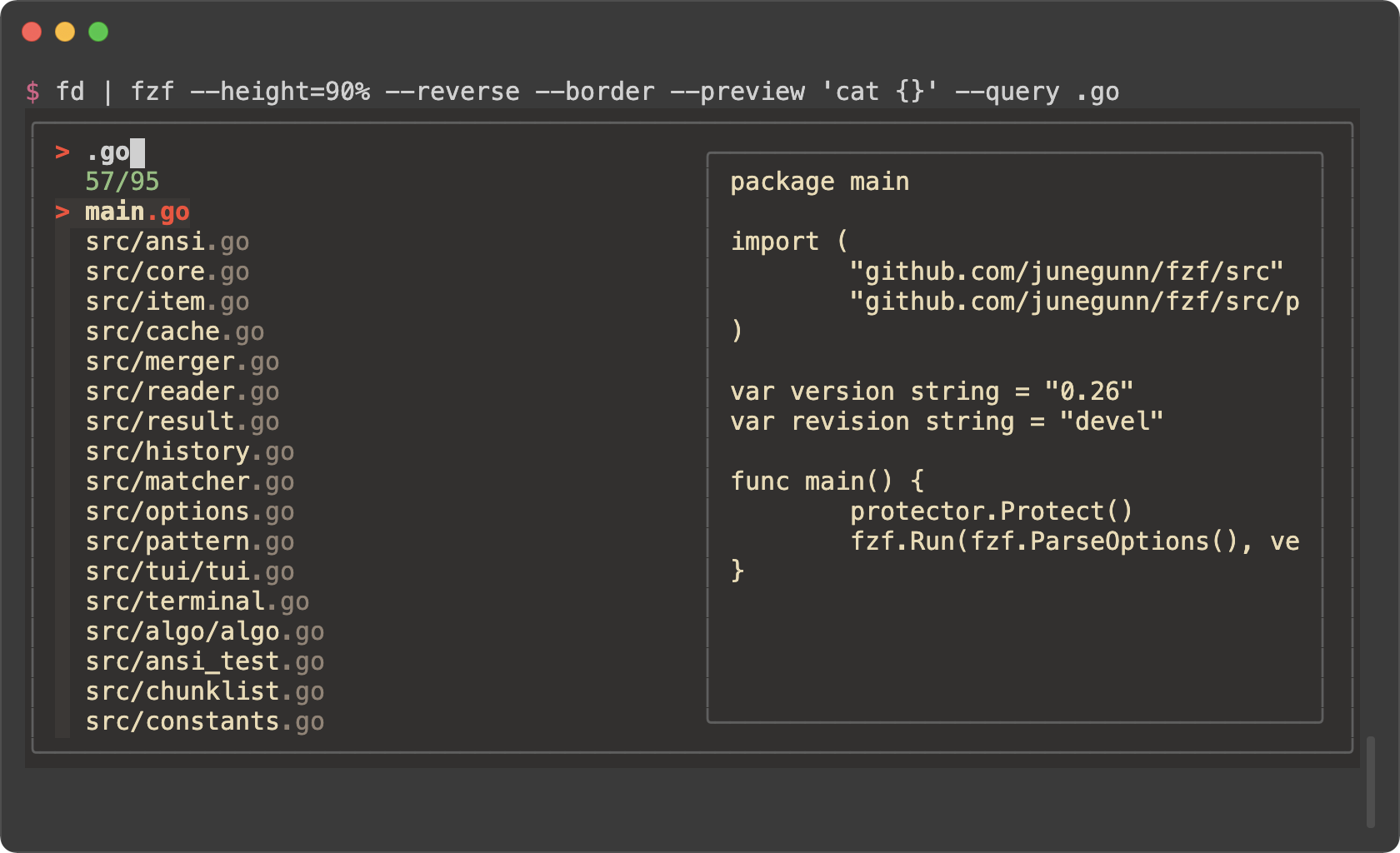
|
|
512
|
+
|
|
513
|
+
```sh
|
|
514
|
+
# arcticicestudio/nord-vim
|
|
515
|
+
export FZF_DEFAULT_OPTS='--color=bg+:#3B4252,bg:#2E3440,spinner:#81A1C1,hl:#616E88,fg:#D8DEE9,header:#616E88,info:#81A1C1,pointer:#81A1C1,marker:#81A1C1,fg+:#D8DEE9,prompt:#81A1C1,hl+:#81A1C1'
|
|
516
|
+
```
|
|
517
|
+
|
|
518
|
+
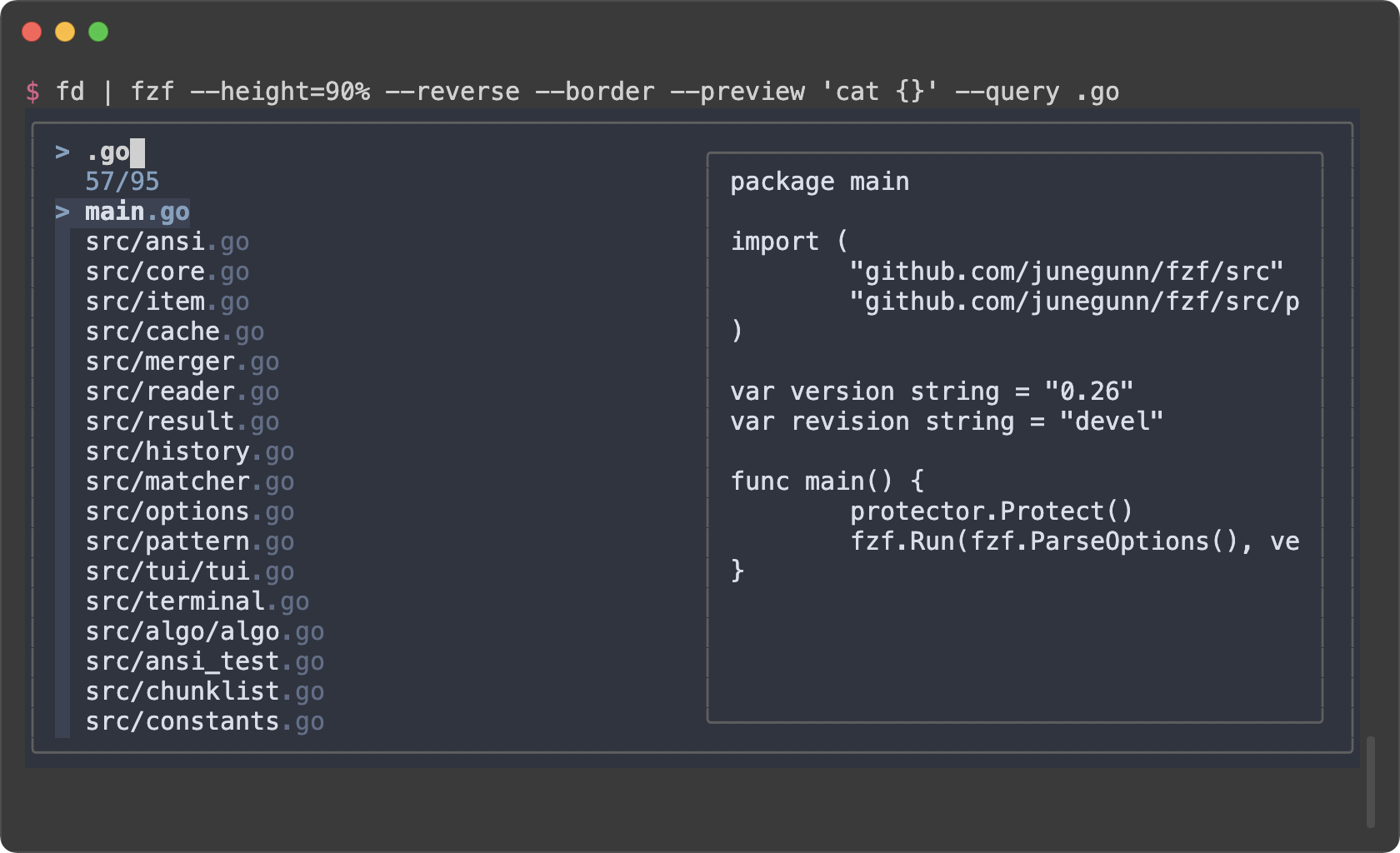
|
|
519
|
+
|
|
520
|
+
```sh
|
|
521
|
+
# tomasr/molokai
|
|
522
|
+
export FZF_DEFAULT_OPTS='--color=bg+:#293739,bg:#1B1D1E,border:#808080,spinner:#E6DB74,hl:#7E8E91,fg:#F8F8F2,header:#7E8E91,info:#A6E22E,pointer:#A6E22E,marker:#F92672,fg+:#F8F8F2,prompt:#F92672,hl+:#F92672'
|
|
523
|
+
```
|
|
524
|
+
|
|
525
|
+
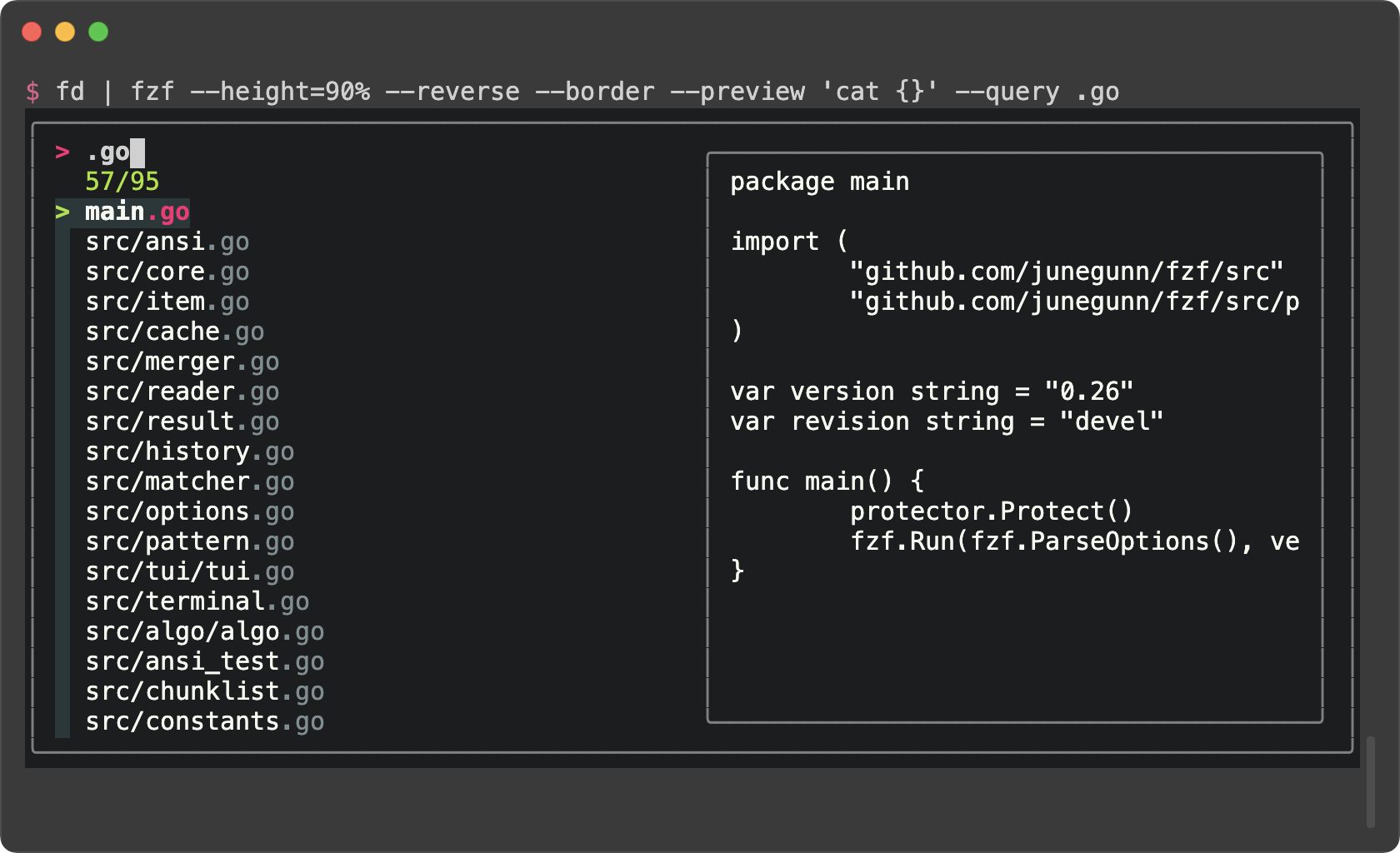
|
|
526
|
+
|
|
527
|
+
### Generating fzf color theme from Vim color schemes
|
|
528
|
+
|
|
529
|
+
The Vim plugin of fzf can generate `--color` option from the current color
|
|
530
|
+
scheme according to `g:fzf_colors` variable. You can find the detailed
|
|
531
|
+
explanation [here](https://github.com/junegunn/fzf/blob/master/README-VIM.md#explanation-of-gfzf_colors).
|
|
532
|
+
|
|
533
|
+
Here is an example. Add this to your Vim configuration file.
|
|
534
|
+
|
|
535
|
+
```vim
|
|
536
|
+
let g:fzf_colors =
|
|
537
|
+
\ { 'fg': ['fg', 'Normal'],
|
|
538
|
+
\ 'bg': ['bg', 'Normal'],
|
|
539
|
+
\ 'preview-bg': ['bg', 'NormalFloat'],
|
|
540
|
+
\ 'hl': ['fg', 'Comment'],
|
|
541
|
+
\ 'fg+': ['fg', 'CursorLine', 'CursorColumn', 'Normal'],
|
|
542
|
+
\ 'bg+': ['bg', 'CursorLine', 'CursorColumn'],
|
|
543
|
+
\ 'hl+': ['fg', 'Statement'],
|
|
544
|
+
\ 'info': ['fg', 'PreProc'],
|
|
545
|
+
\ 'border': ['fg', 'Ignore'],
|
|
546
|
+
\ 'prompt': ['fg', 'Conditional'],
|
|
547
|
+
\ 'pointer': ['fg', 'Exception'],
|
|
548
|
+
\ 'marker': ['fg', 'Keyword'],
|
|
549
|
+
\ 'spinner': ['fg', 'Label'],
|
|
550
|
+
\ 'header': ['fg', 'Comment'] }
|
|
551
|
+
```
|
|
552
|
+
|
|
553
|
+
Then you can see how the `--color` option is generated by printing the result
|
|
554
|
+
of `fzf#wrap()`.
|
|
555
|
+
|
|
556
|
+
```vim
|
|
557
|
+
:echo fzf#wrap()
|
|
558
|
+
```
|
|
559
|
+
|
|
560
|
+
Use this command to append `export FZF_DEFAULT_OPTS="..."` line to the end of
|
|
561
|
+
the current file.
|
|
562
|
+
|
|
563
|
+
```vim
|
|
564
|
+
:call append('$', printf('export FZF_DEFAULT_OPTS="%s"', matchstr(fzf#wrap().options, "--color[^']*")))
|
|
565
|
+
```
|
|
@@ -0,0 +1,49 @@
|
|
|
1
|
+
Building fzf
|
|
2
|
+
============
|
|
3
|
+
|
|
4
|
+
Build instructions
|
|
5
|
+
------------------
|
|
6
|
+
|
|
7
|
+
### Prerequisites
|
|
8
|
+
|
|
9
|
+
- Go 1.13 or above
|
|
10
|
+
|
|
11
|
+
### Using Makefile
|
|
12
|
+
|
|
13
|
+
```sh
|
|
14
|
+
# Build fzf binary for your platform in target
|
|
15
|
+
make
|
|
16
|
+
|
|
17
|
+
# Build fzf binary and copy it to bin directory
|
|
18
|
+
make install
|
|
19
|
+
|
|
20
|
+
# Build fzf binaries and archives for all platforms using goreleaser
|
|
21
|
+
make build
|
|
22
|
+
|
|
23
|
+
# Publish GitHub release
|
|
24
|
+
make release
|
|
25
|
+
```
|
|
26
|
+
|
|
27
|
+
> :warning: Makefile uses git commands to determine the version and the
|
|
28
|
+
> revision information for `fzf --version`. So if you're building fzf from an
|
|
29
|
+
> environment where its git information is not available, you have to manually
|
|
30
|
+
> set `$FZF_VERSION` and `$FZF_REVISION`.
|
|
31
|
+
>
|
|
32
|
+
> e.g. `FZF_VERSION=0.24.0 FZF_REVISION=tarball make`
|
|
33
|
+
|
|
34
|
+
Third-party libraries used
|
|
35
|
+
--------------------------
|
|
36
|
+
|
|
37
|
+
- [mattn/go-runewidth](https://github.com/mattn/go-runewidth)
|
|
38
|
+
- Licensed under [MIT](http://mattn.mit-license.org)
|
|
39
|
+
- [mattn/go-shellwords](https://github.com/mattn/go-shellwords)
|
|
40
|
+
- Licensed under [MIT](http://mattn.mit-license.org)
|
|
41
|
+
- [mattn/go-isatty](https://github.com/mattn/go-isatty)
|
|
42
|
+
- Licensed under [MIT](http://mattn.mit-license.org)
|
|
43
|
+
- [tcell](https://github.com/gdamore/tcell)
|
|
44
|
+
- Licensed under [Apache License 2.0](https://github.com/gdamore/tcell/blob/master/LICENSE)
|
|
45
|
+
|
|
46
|
+
License
|
|
47
|
+
-------
|
|
48
|
+
|
|
49
|
+
[MIT](LICENSE)
|